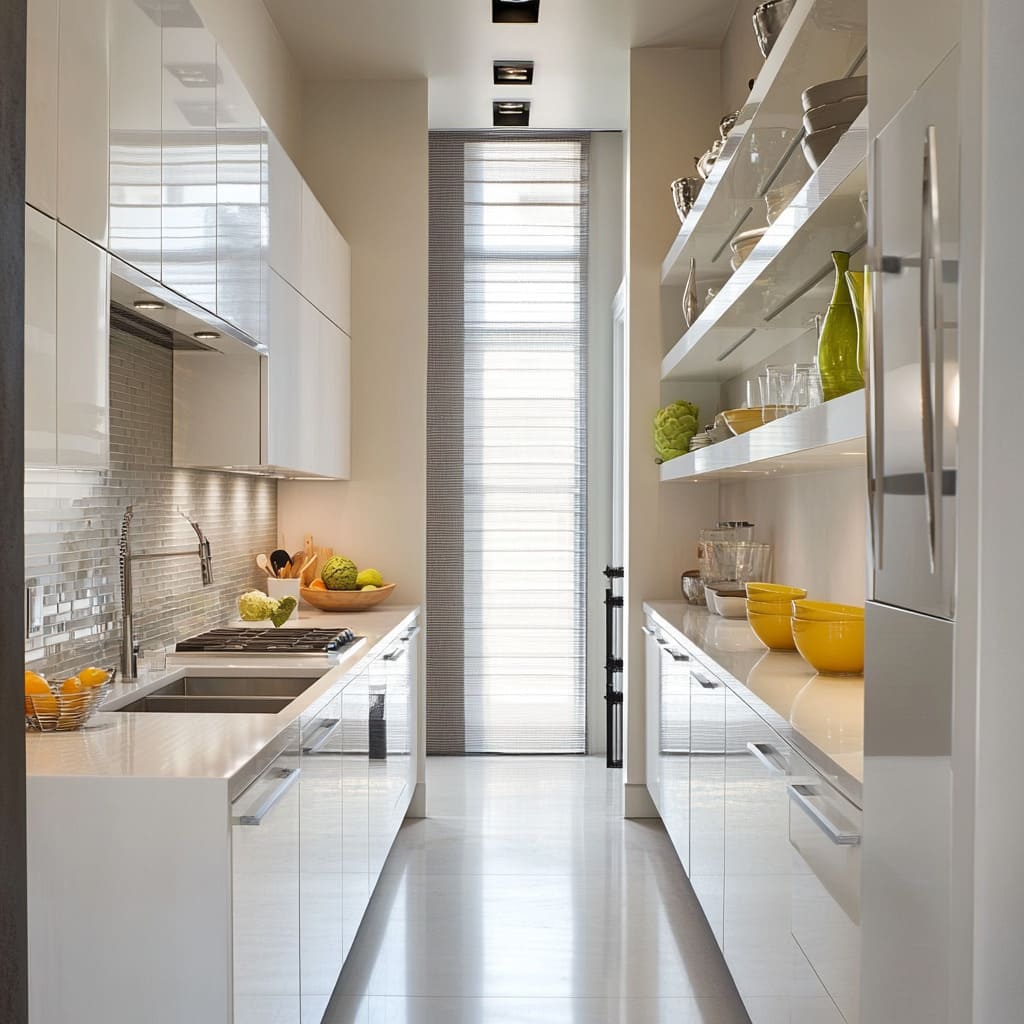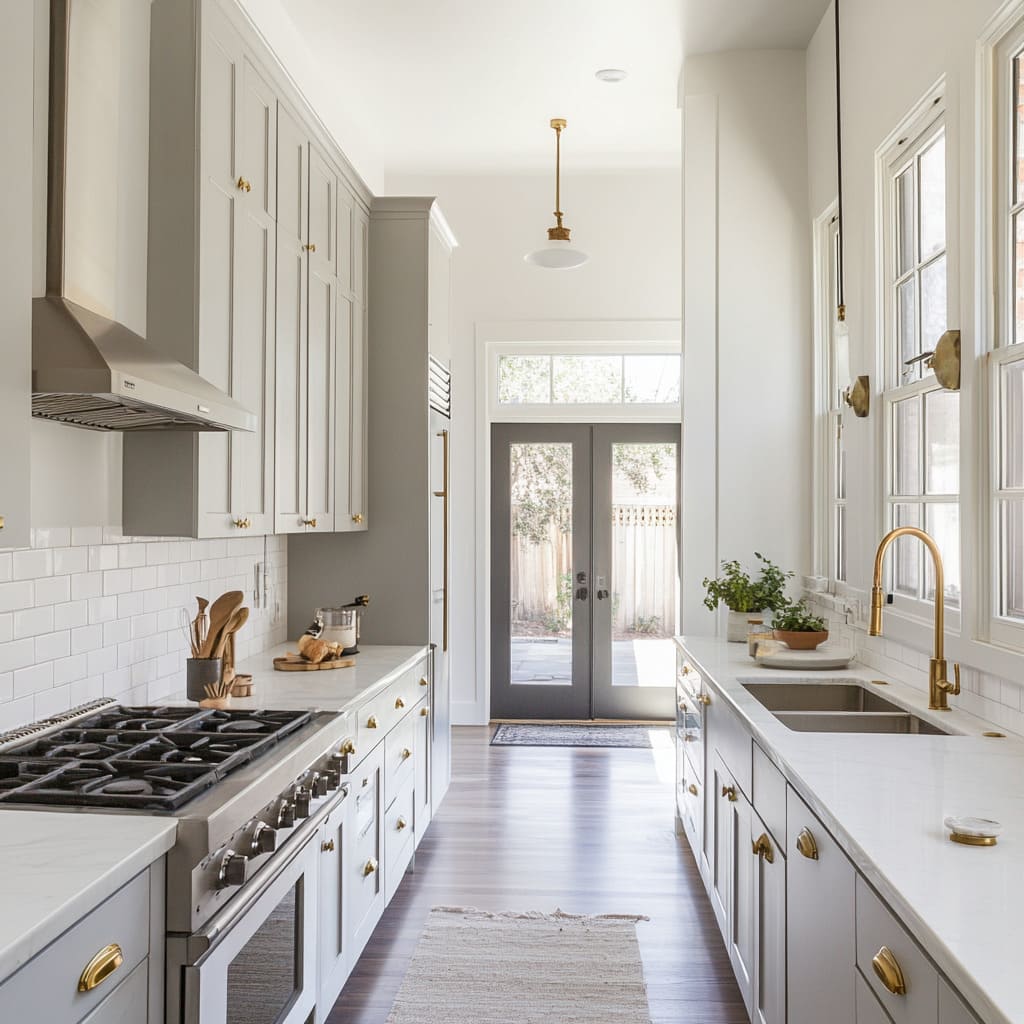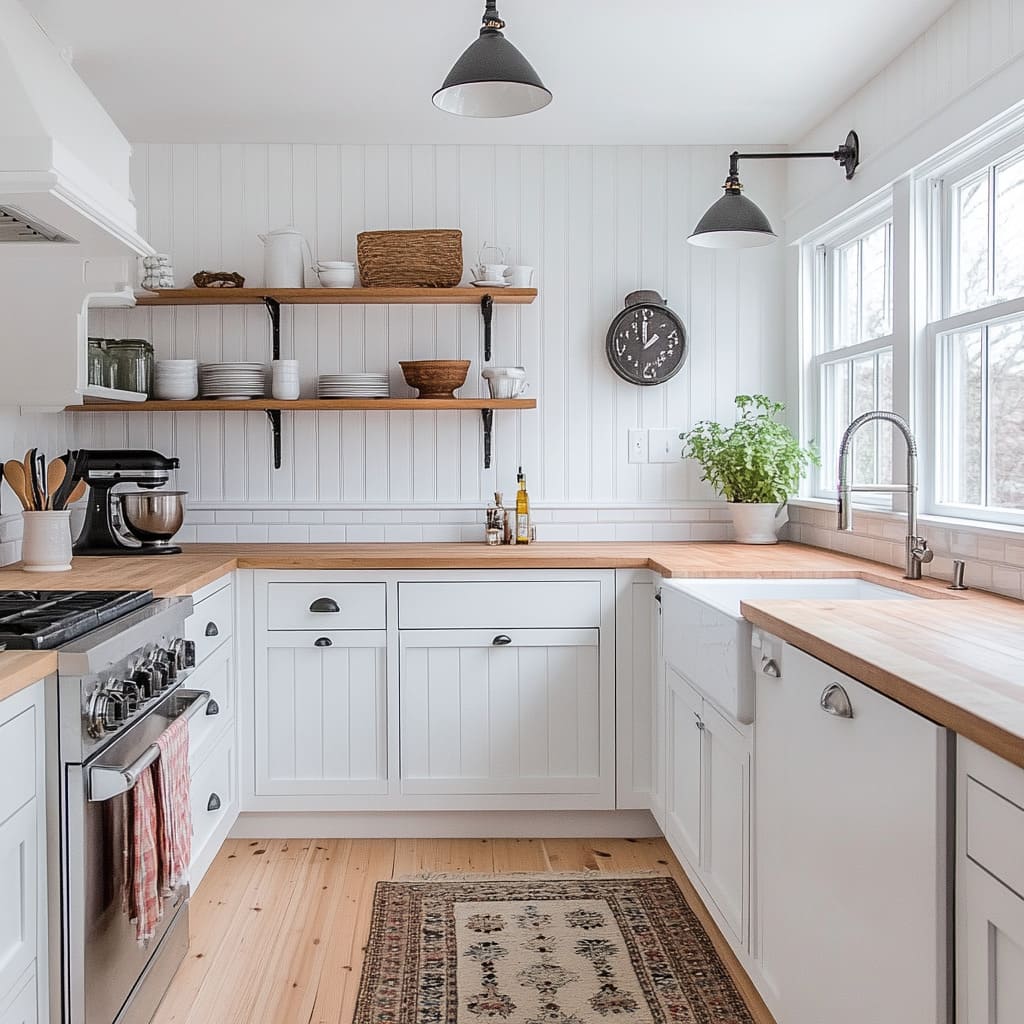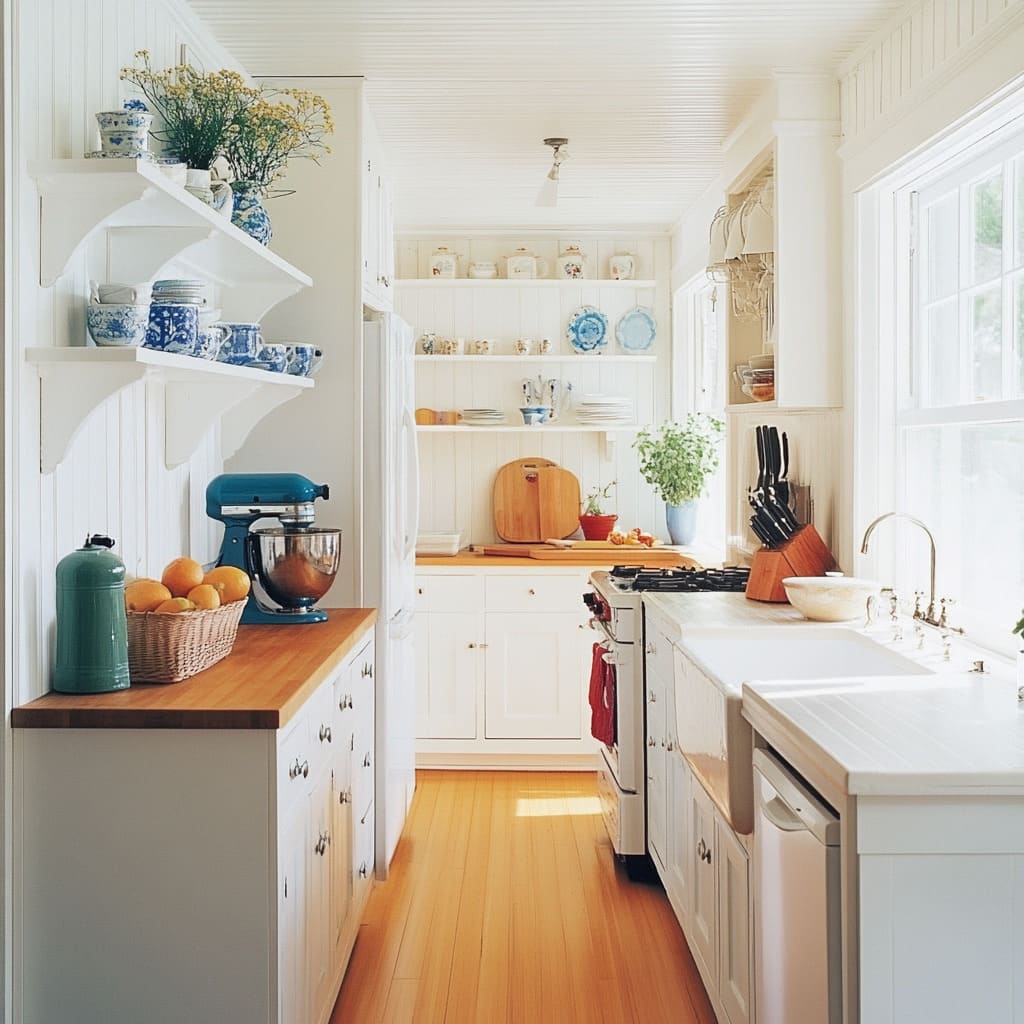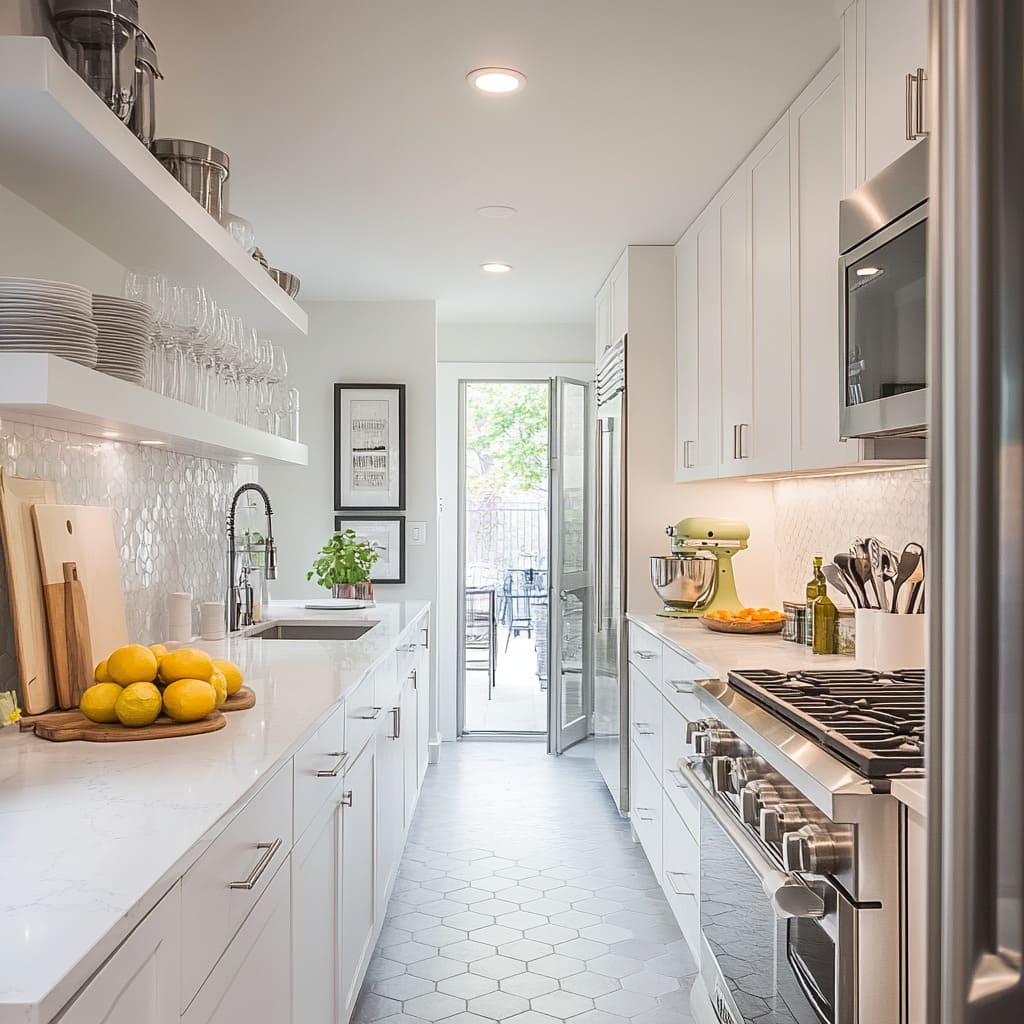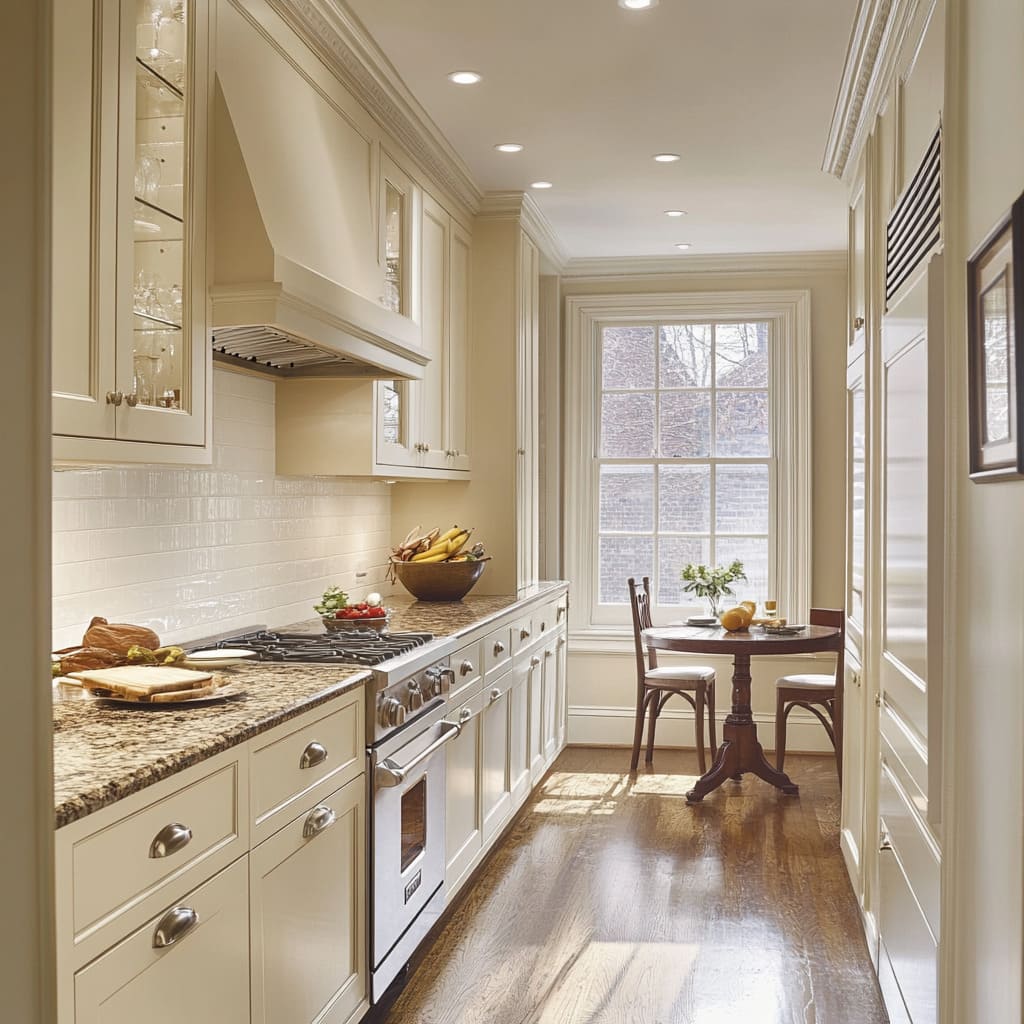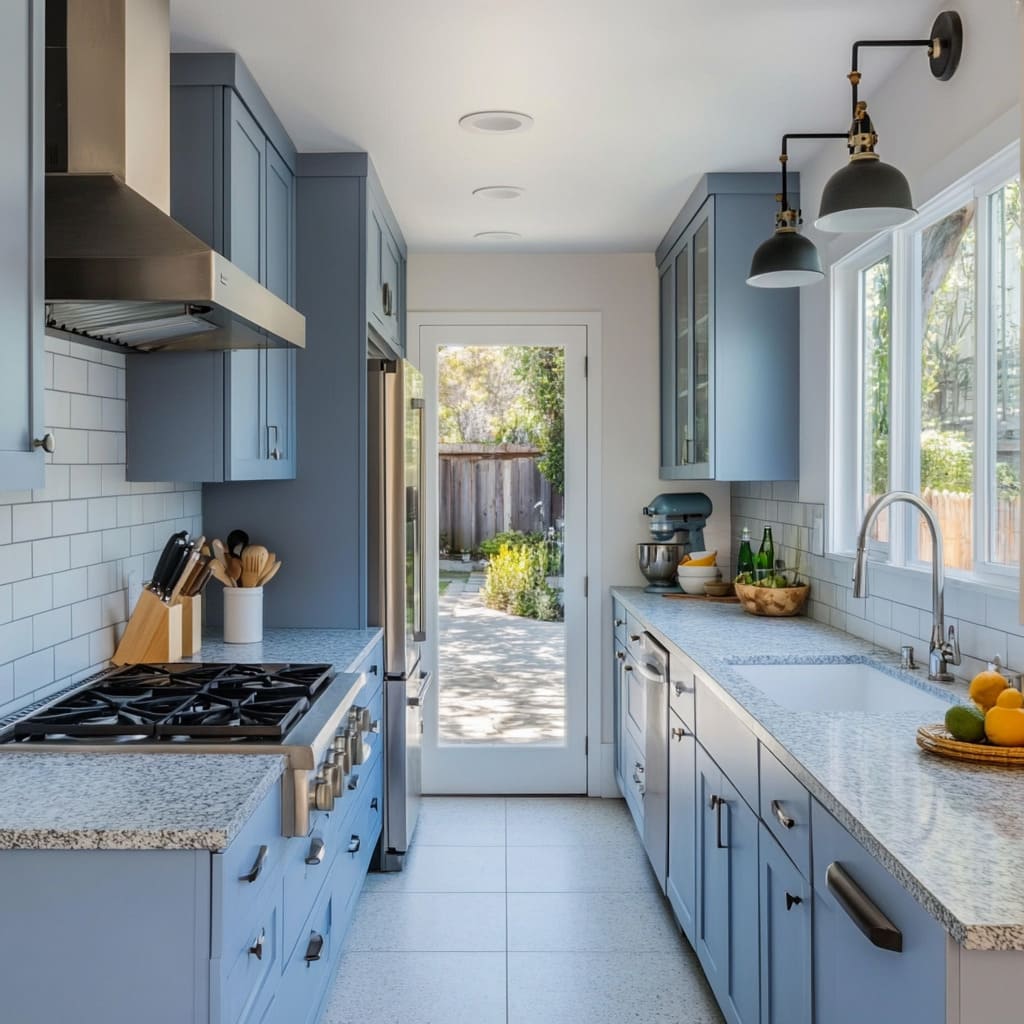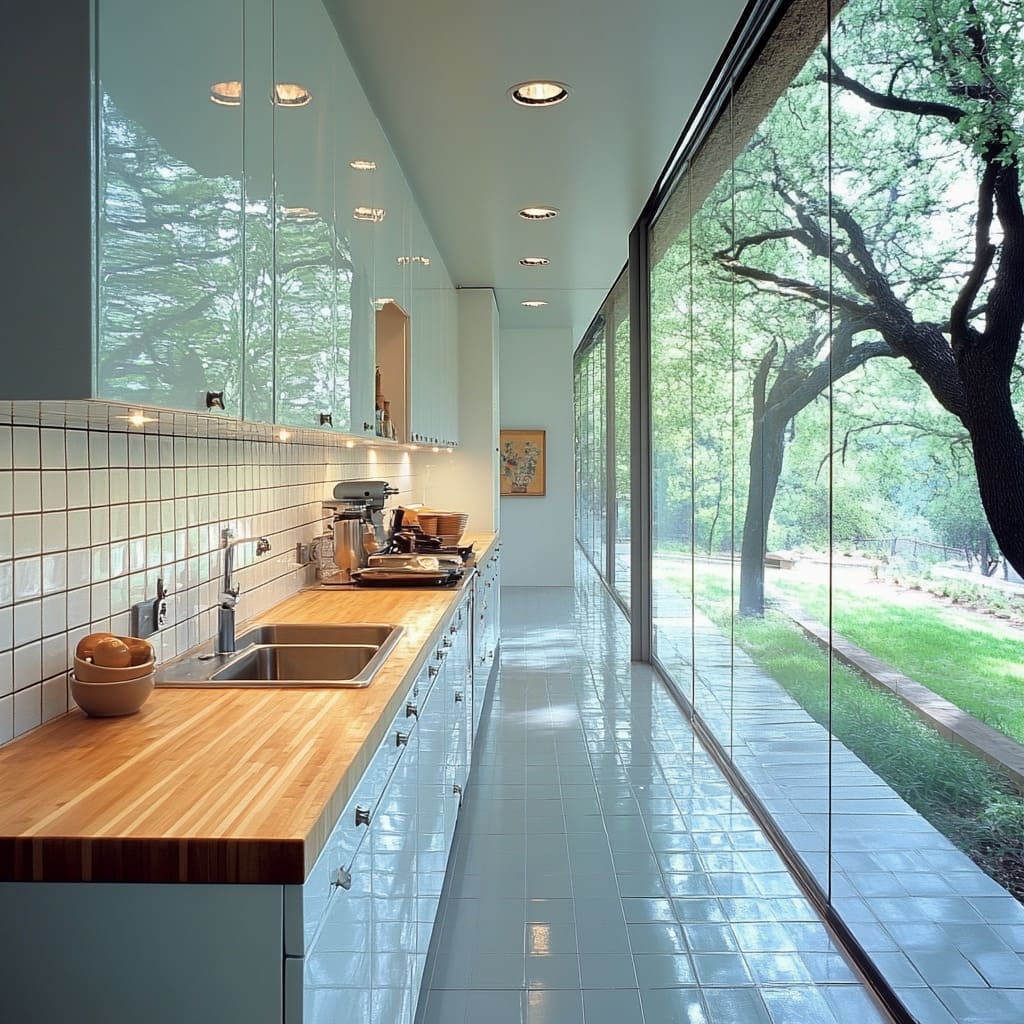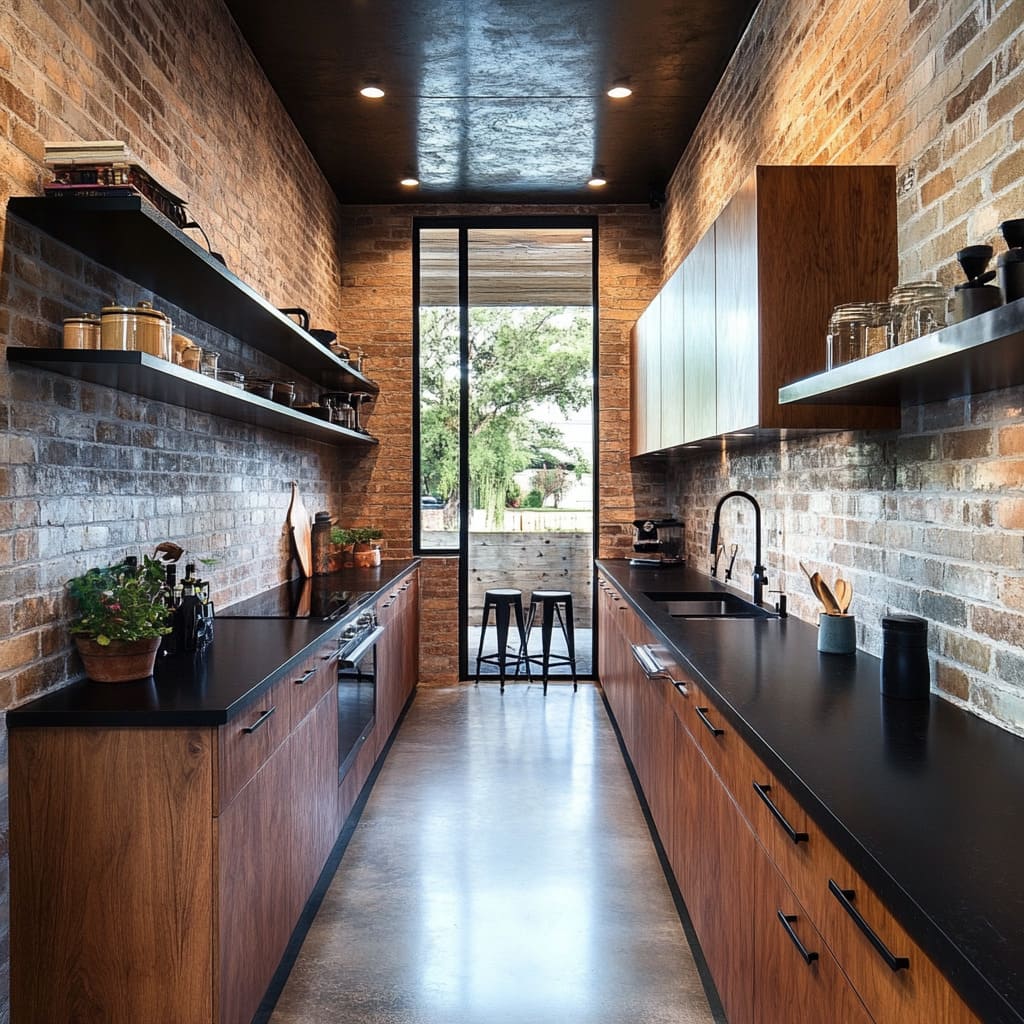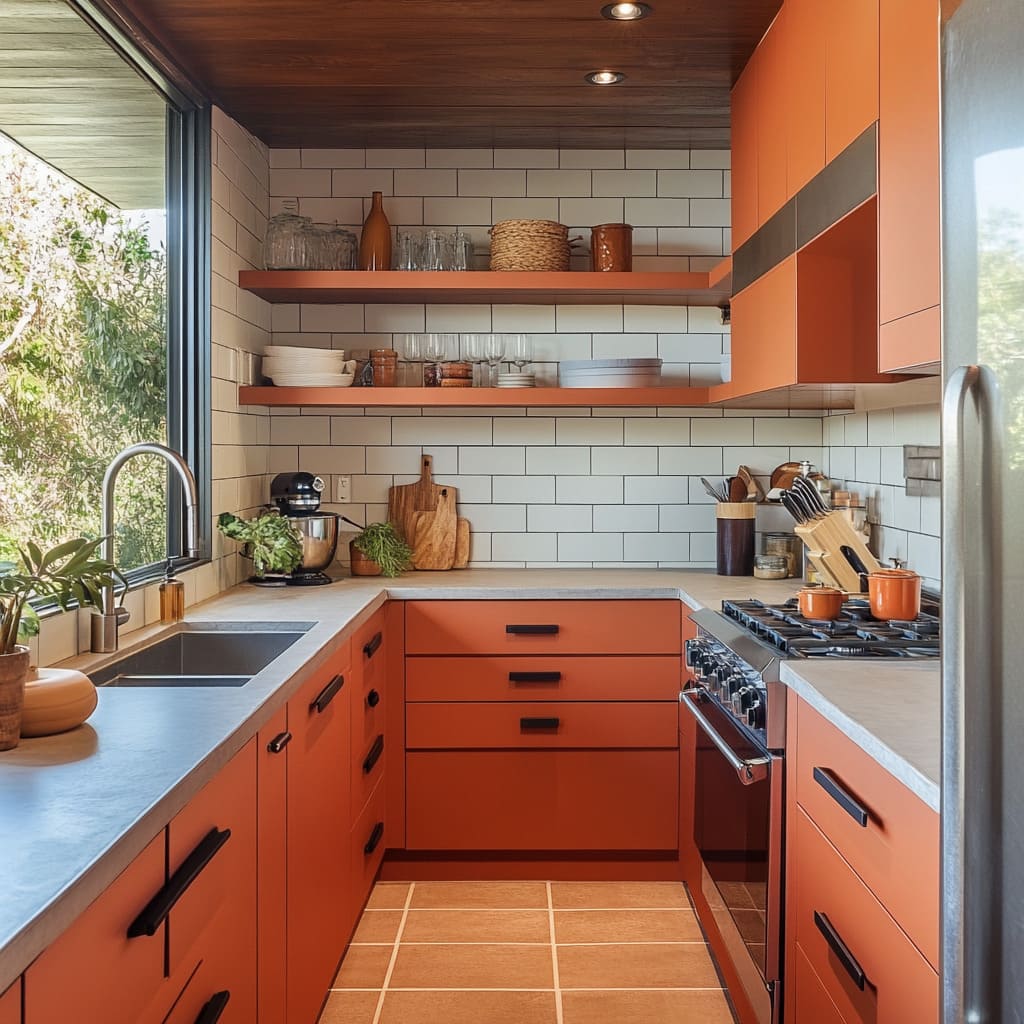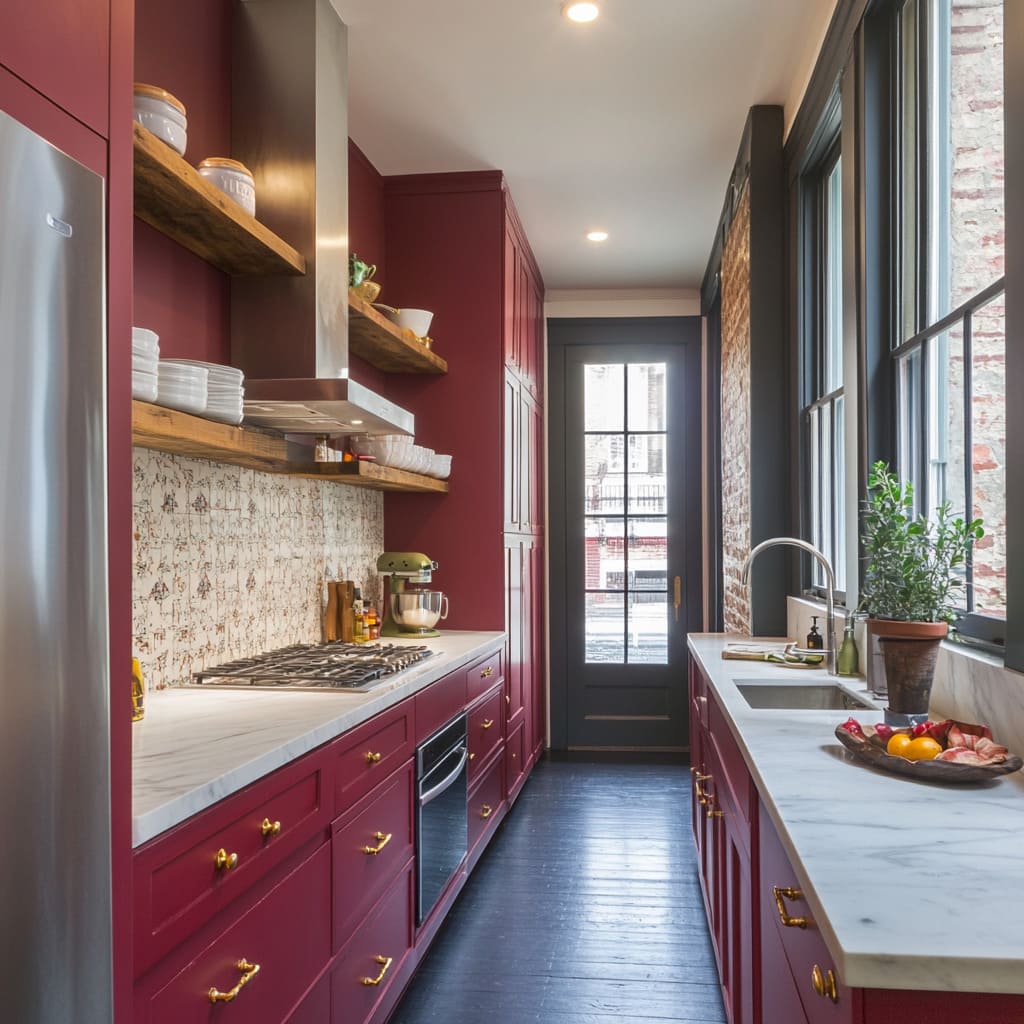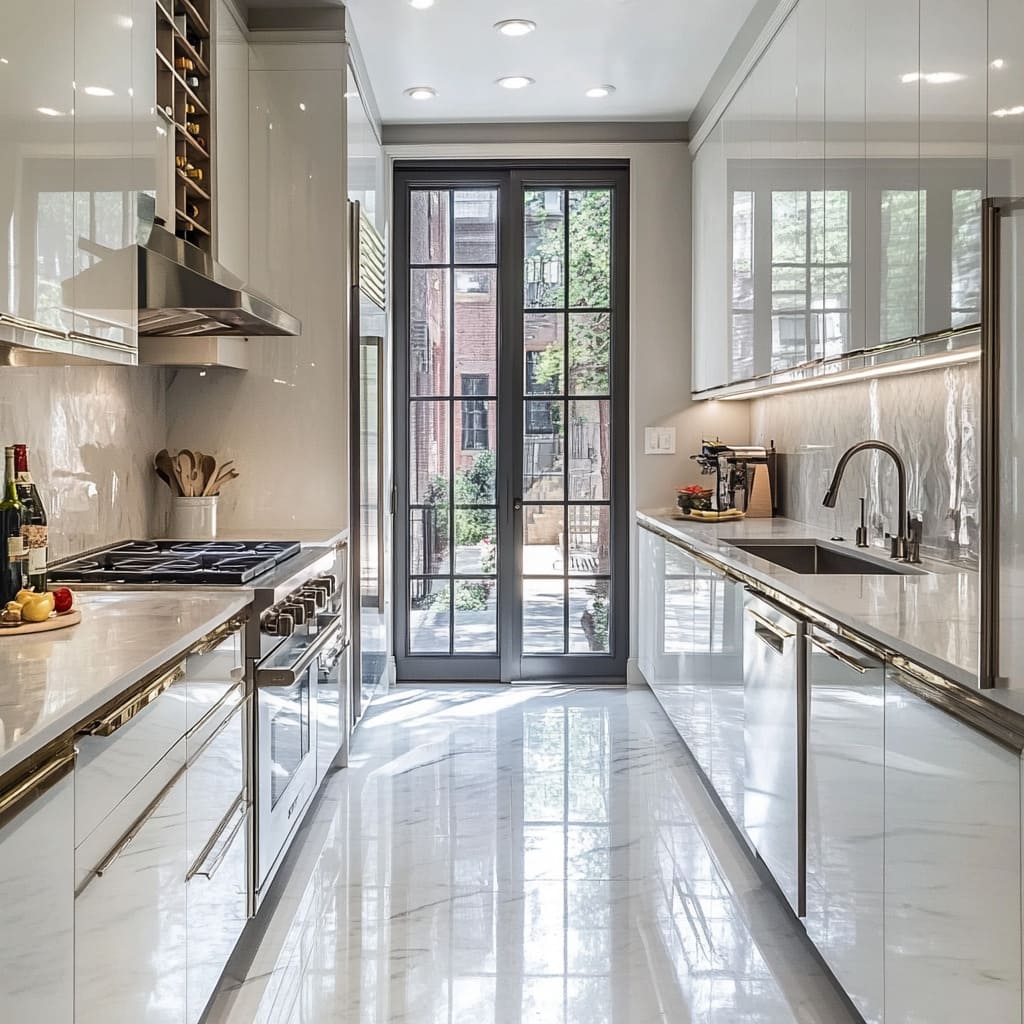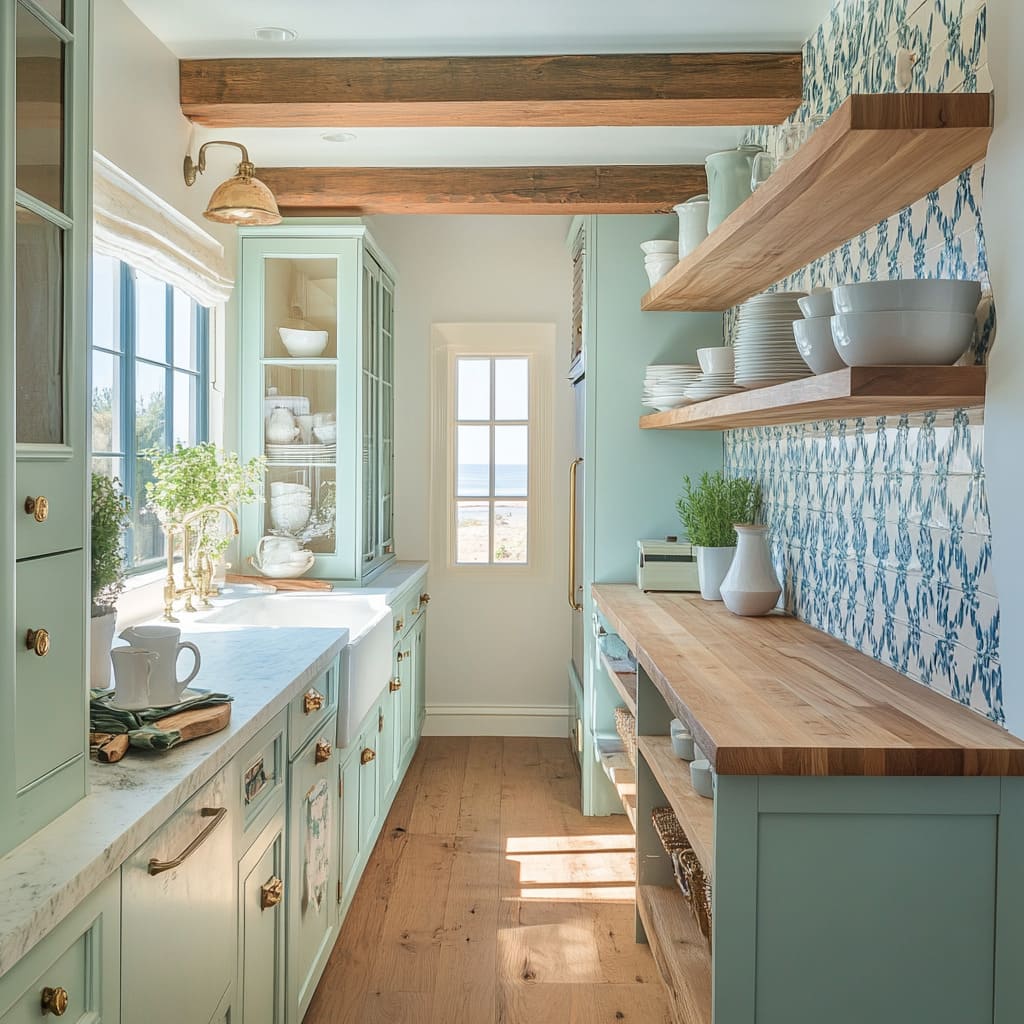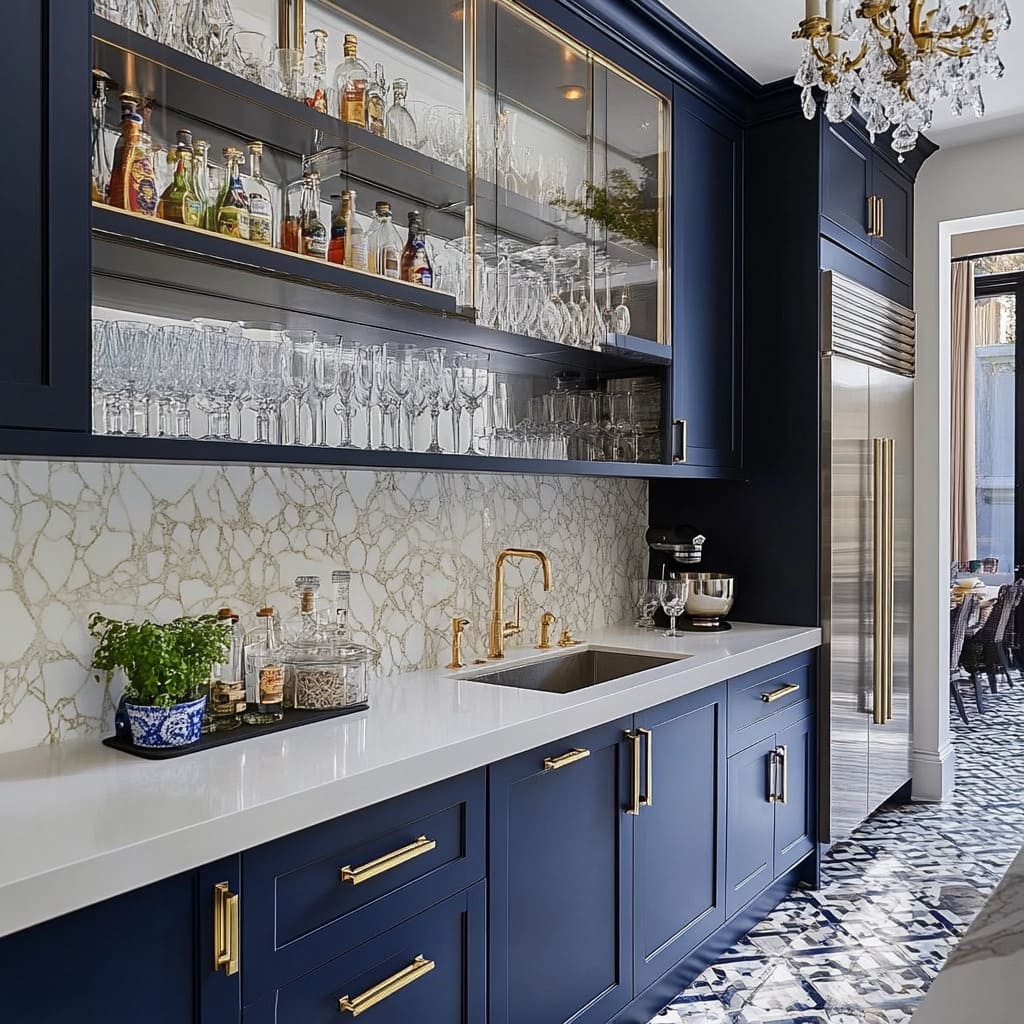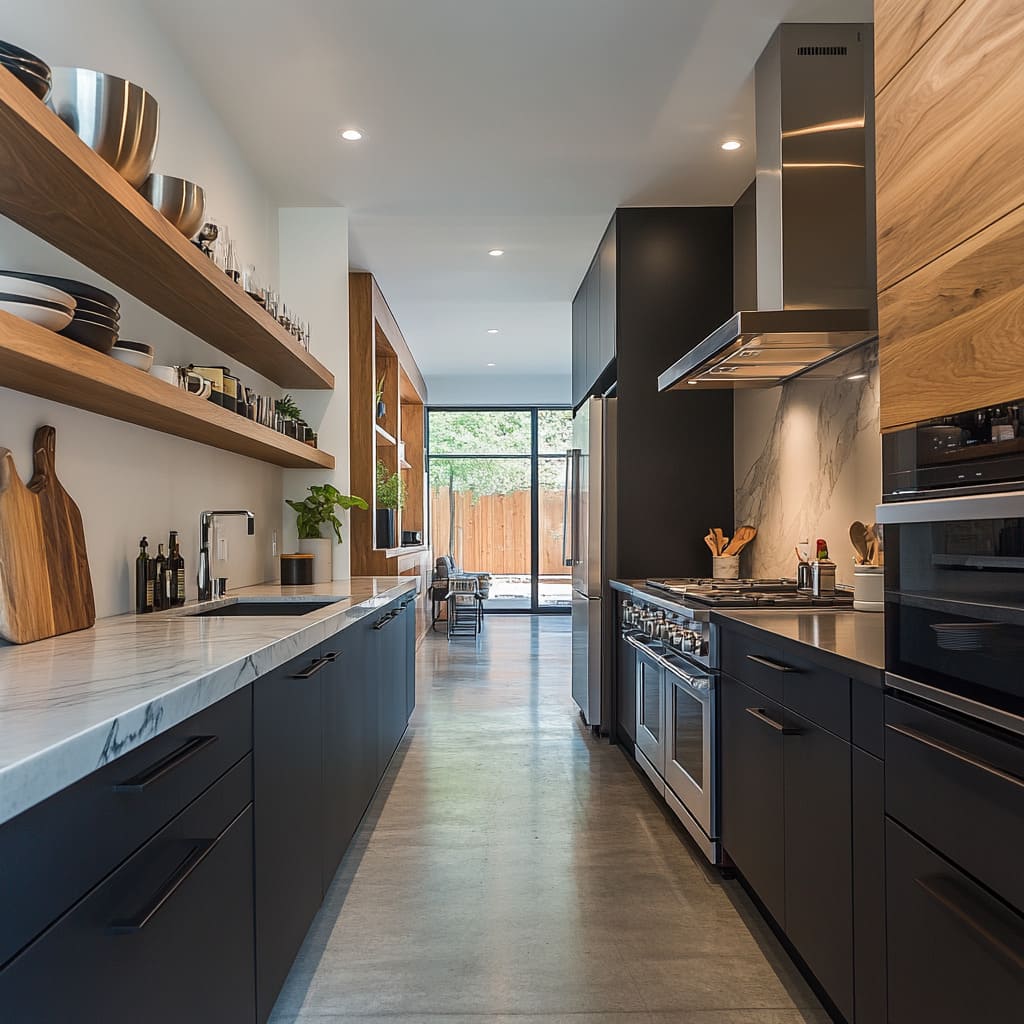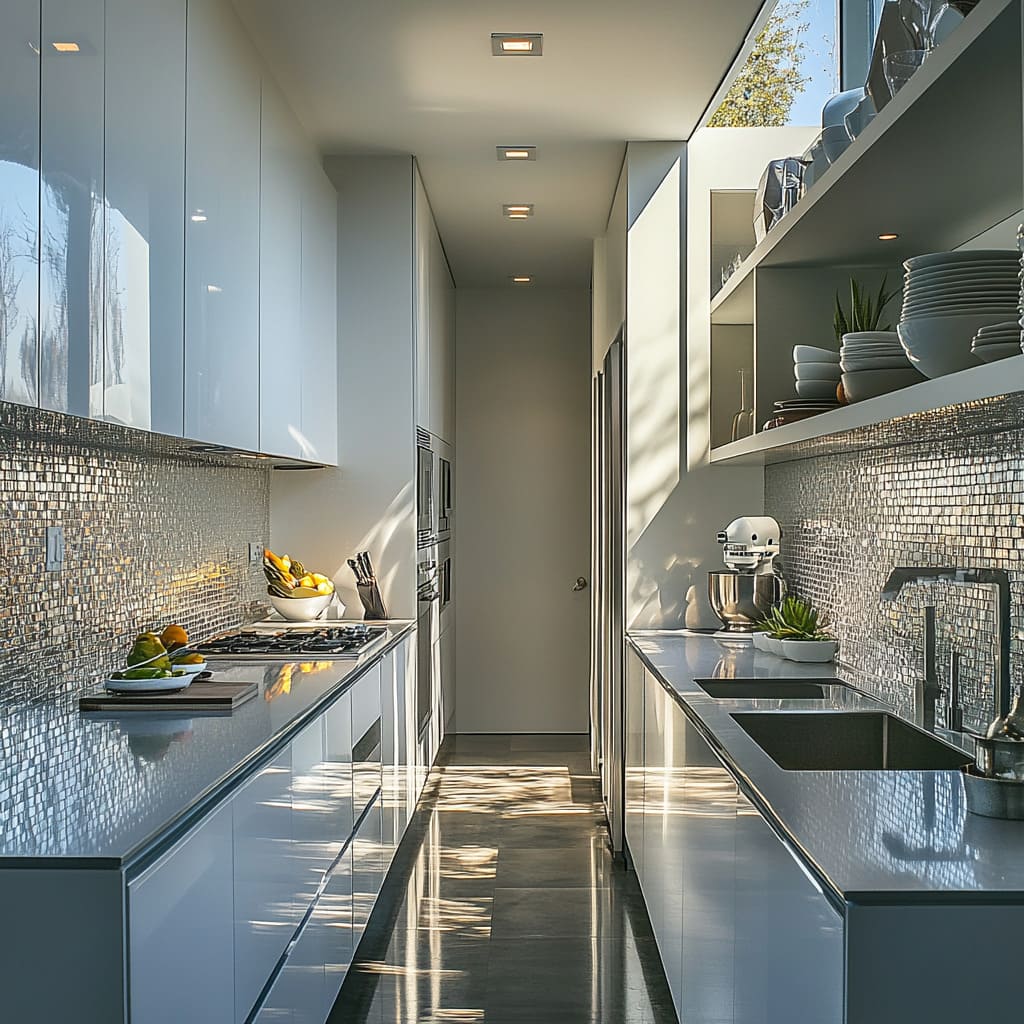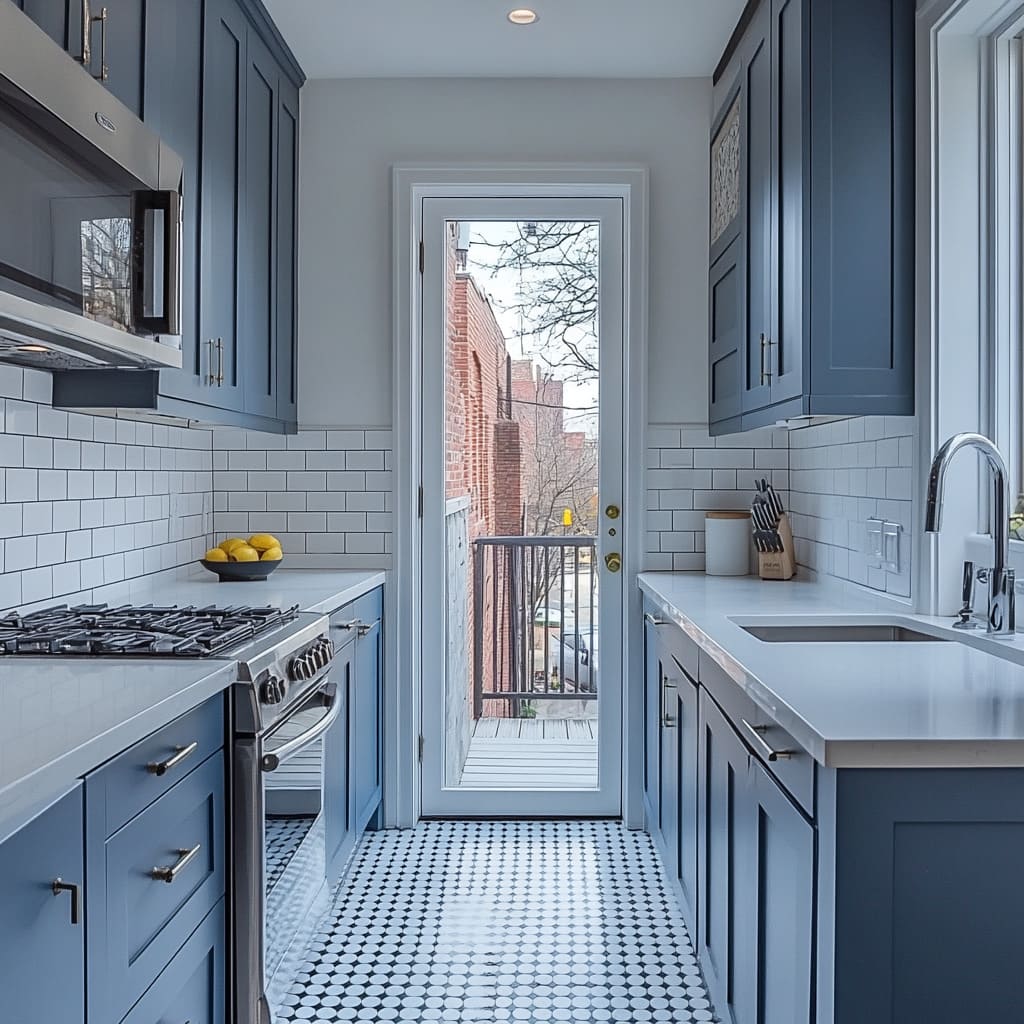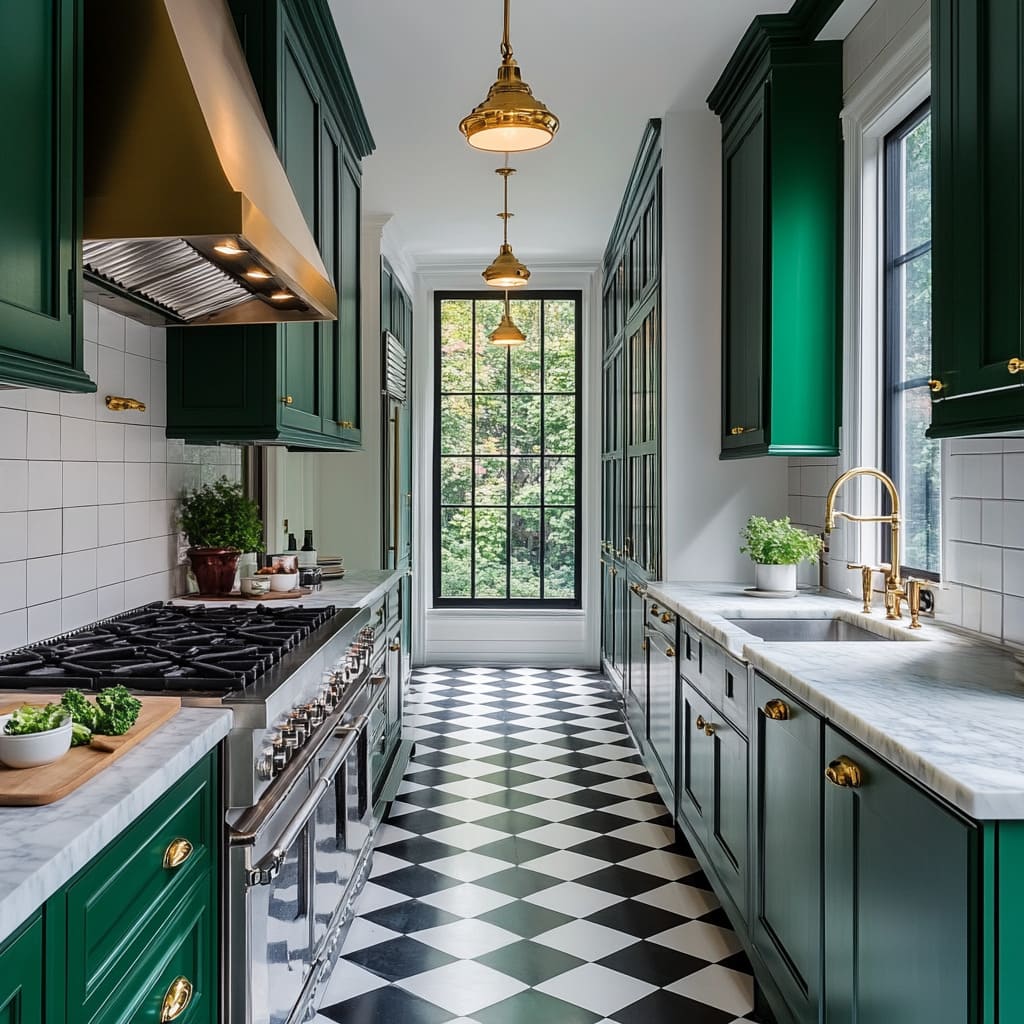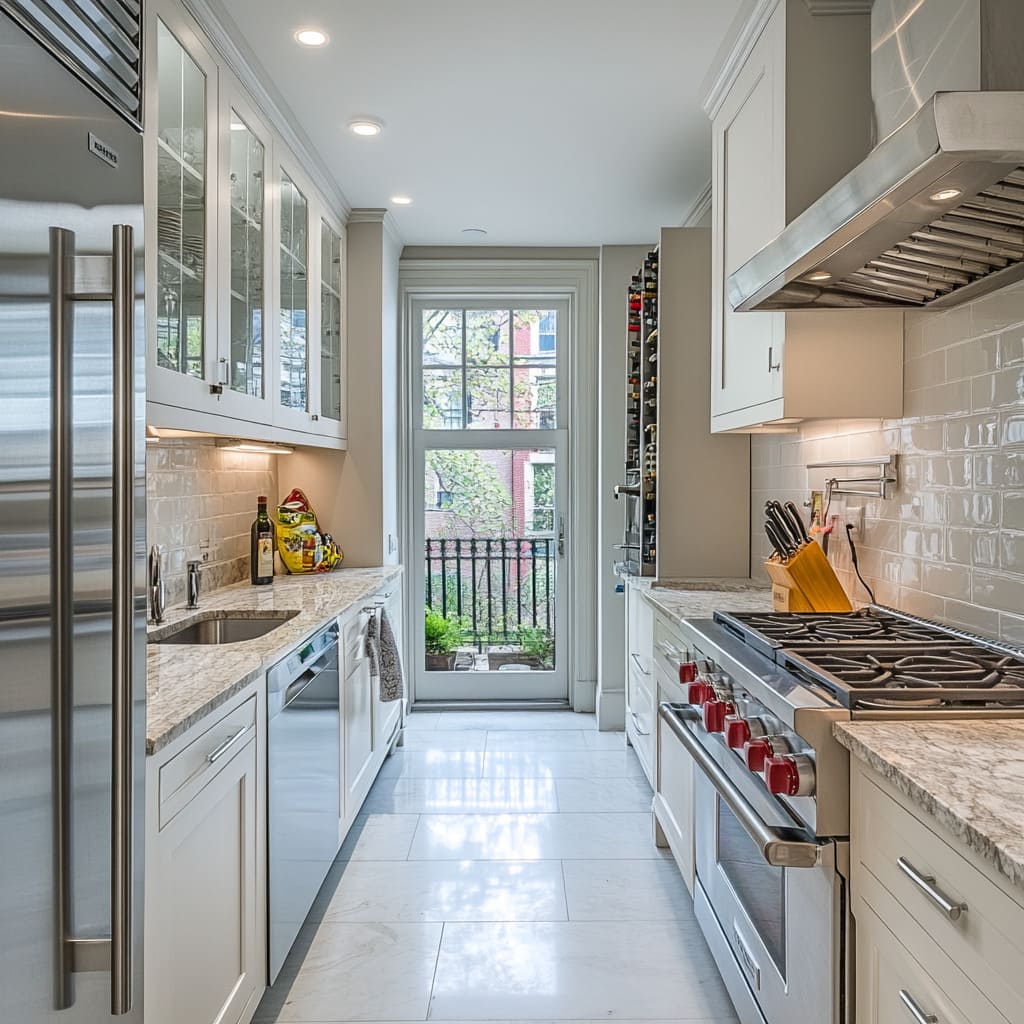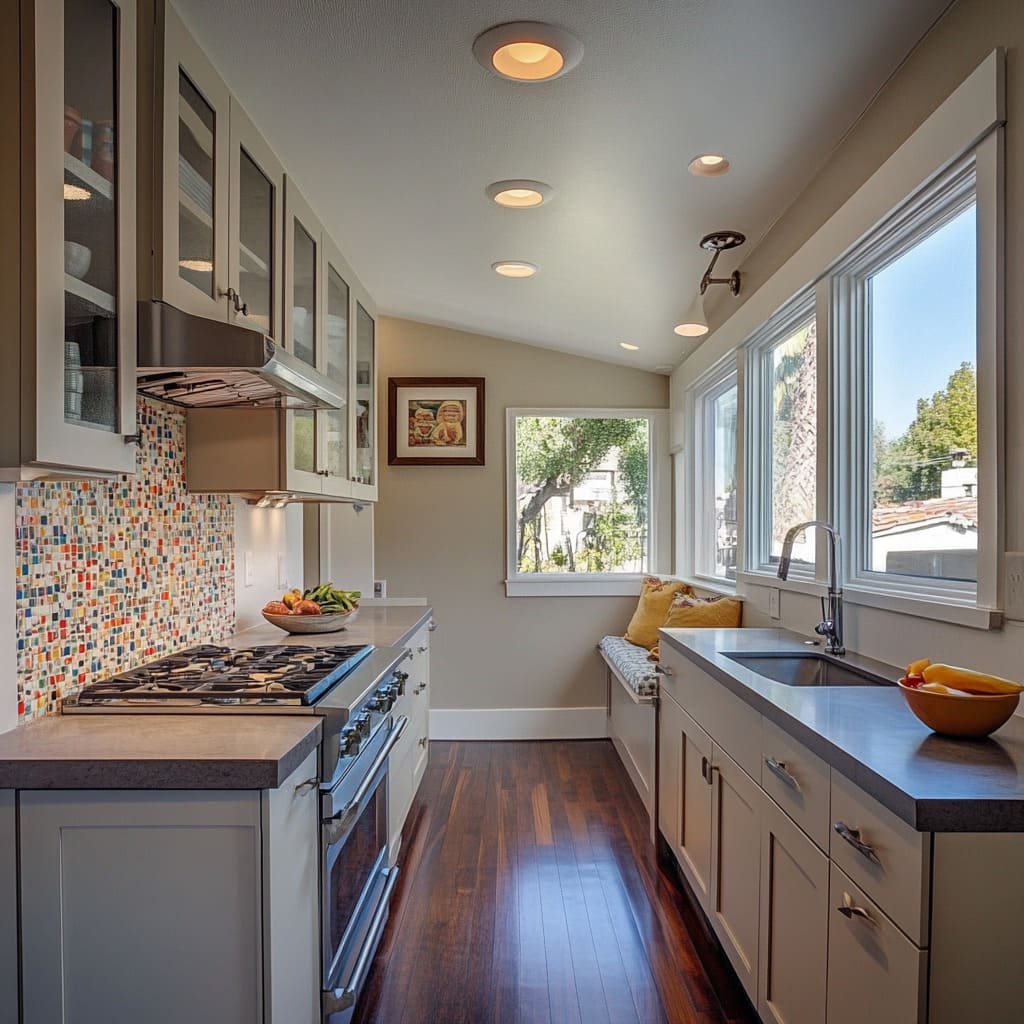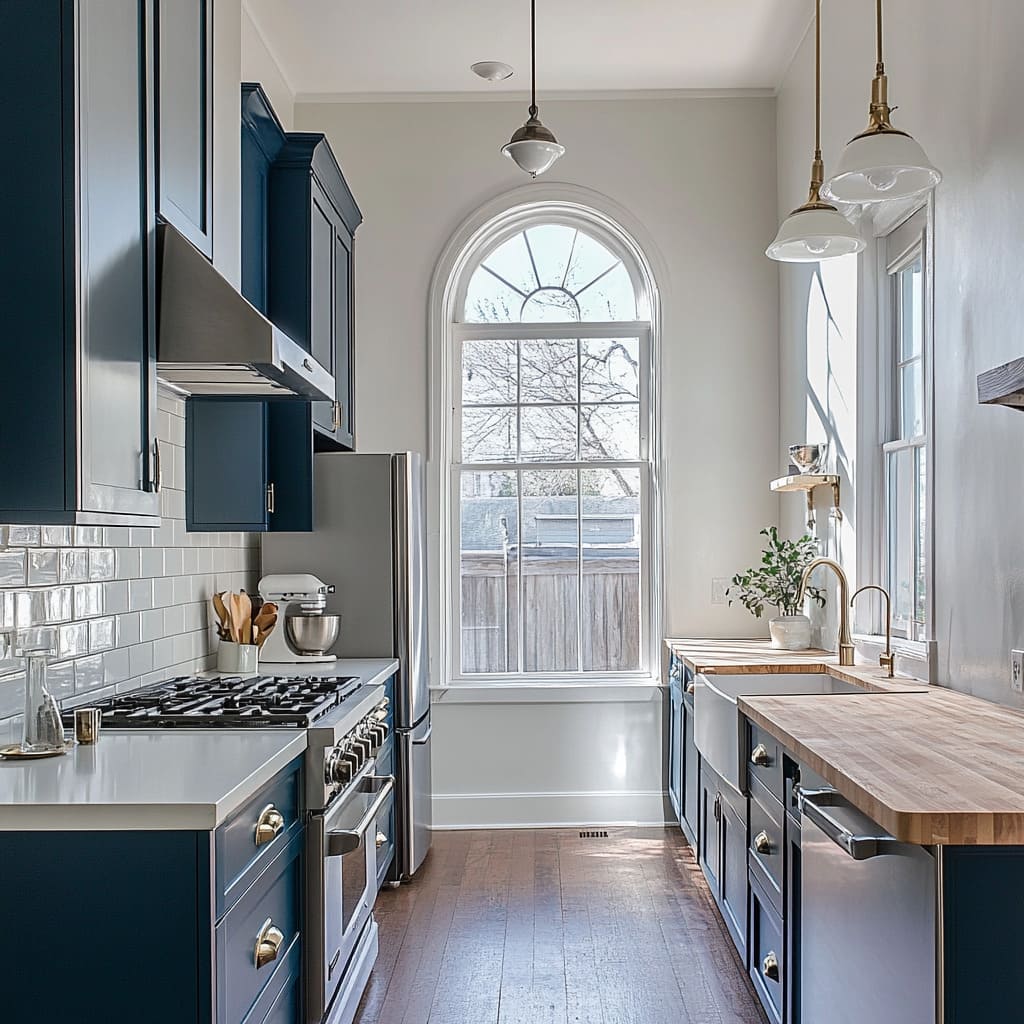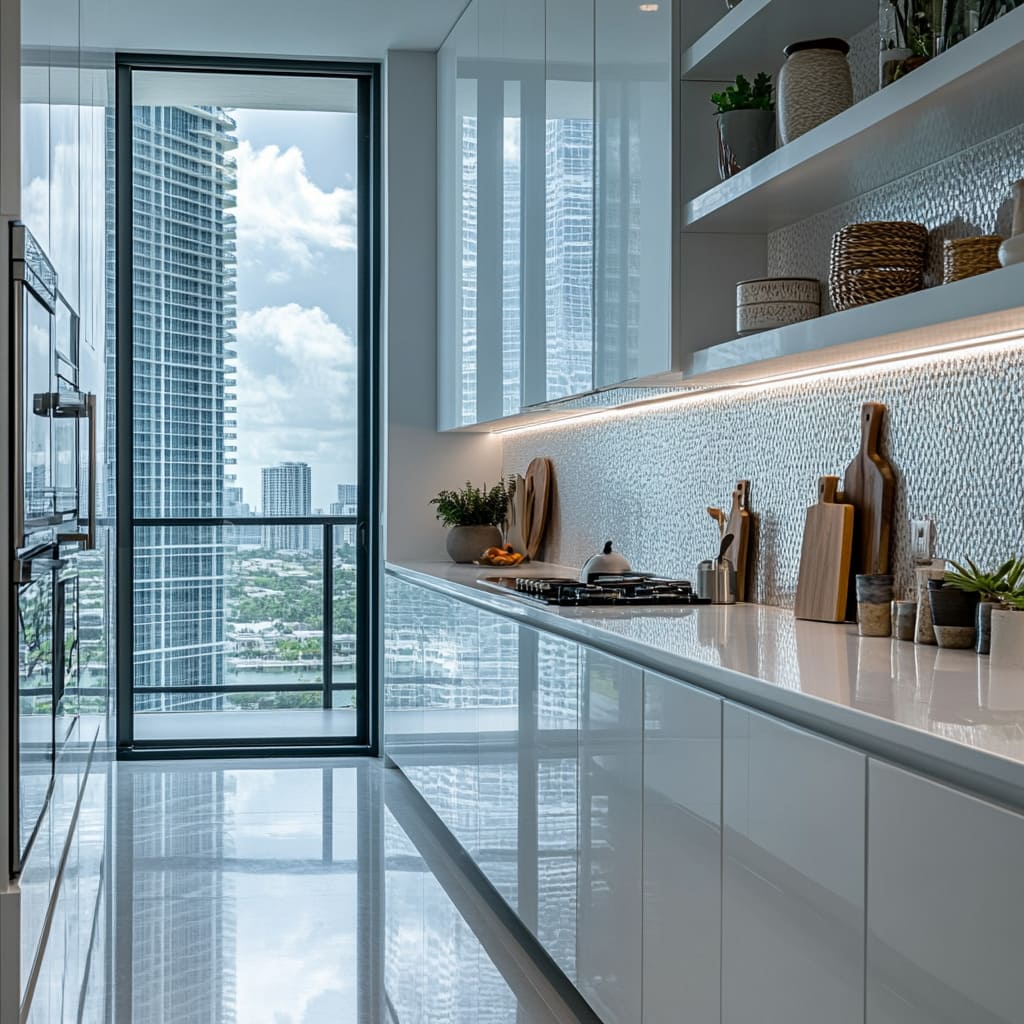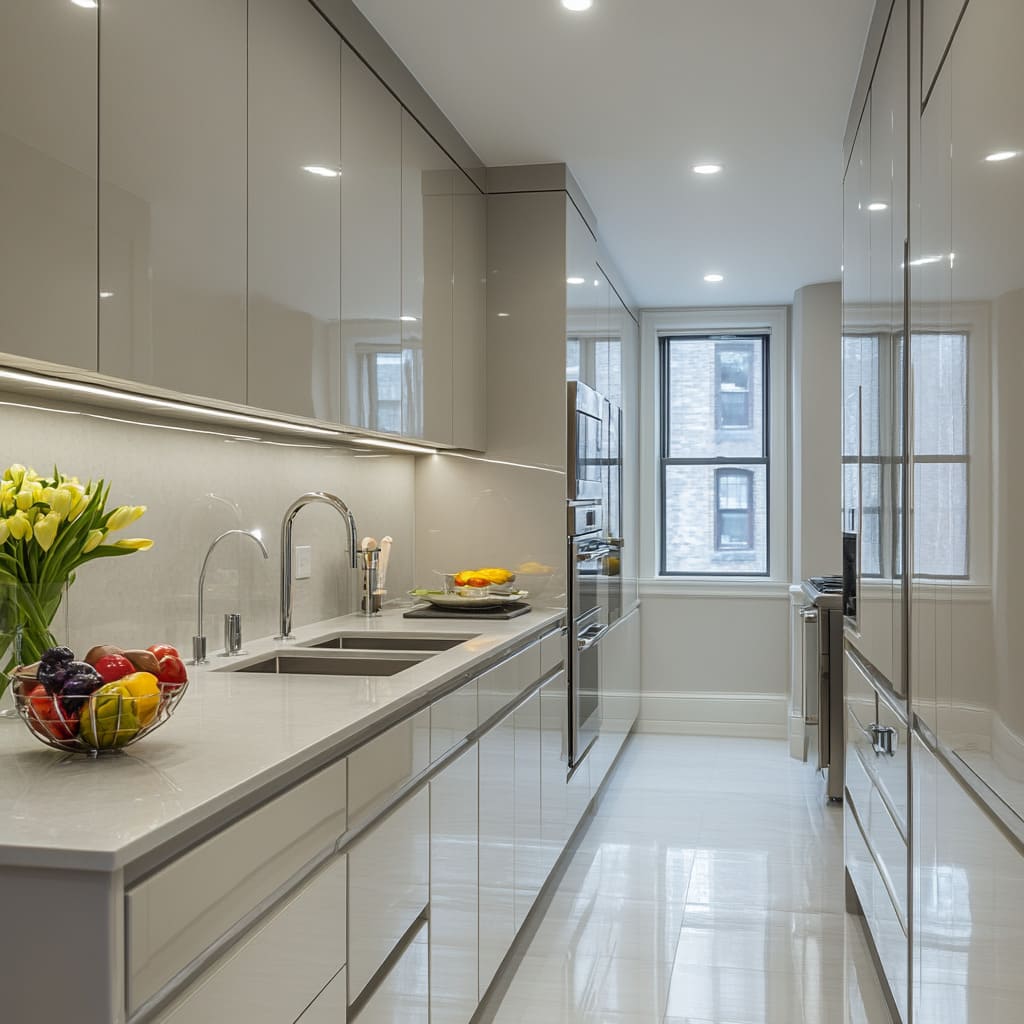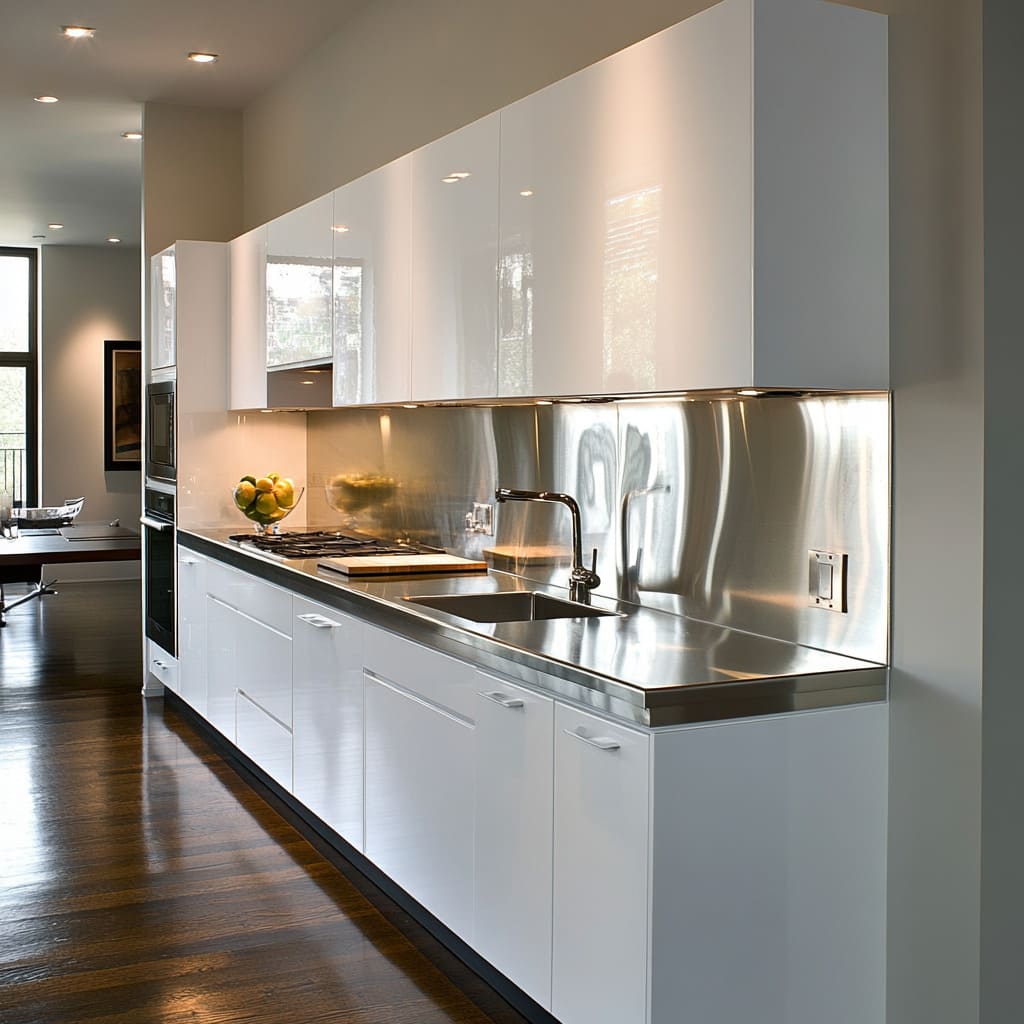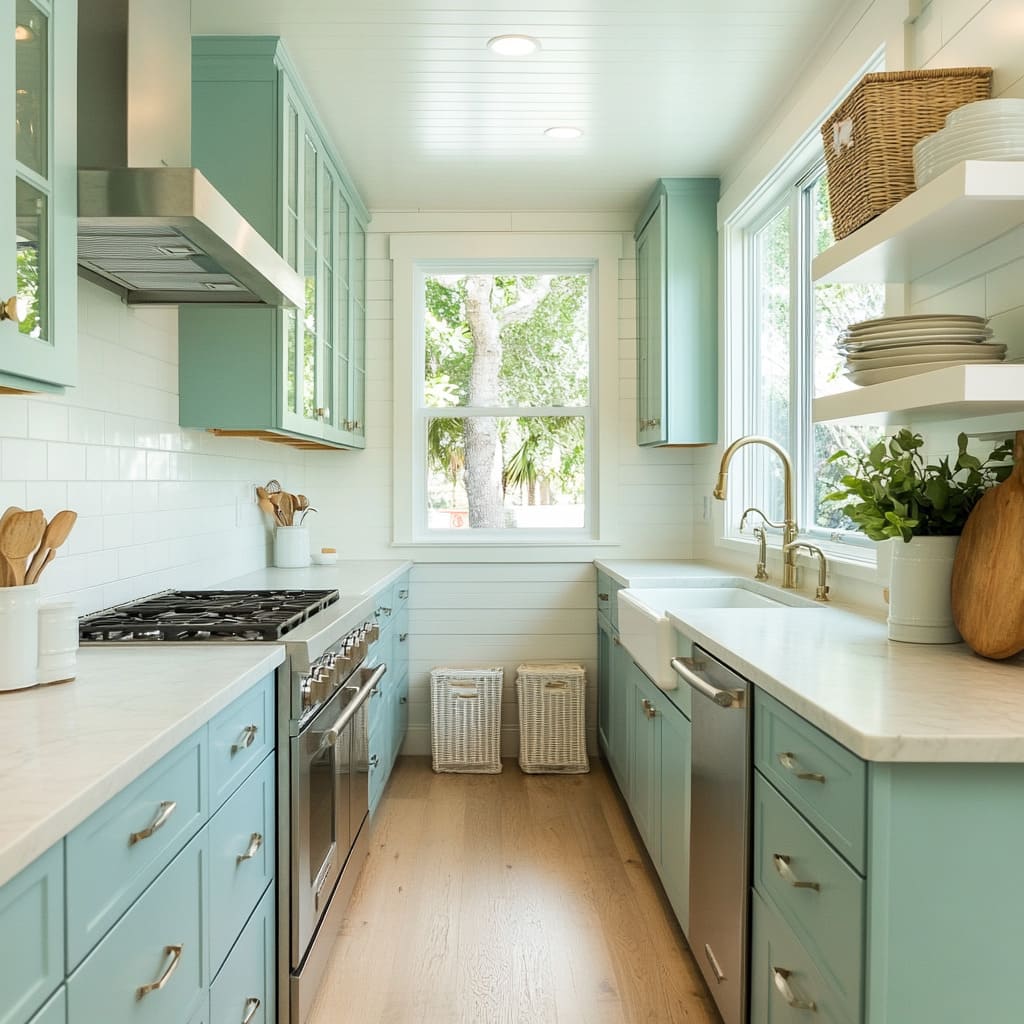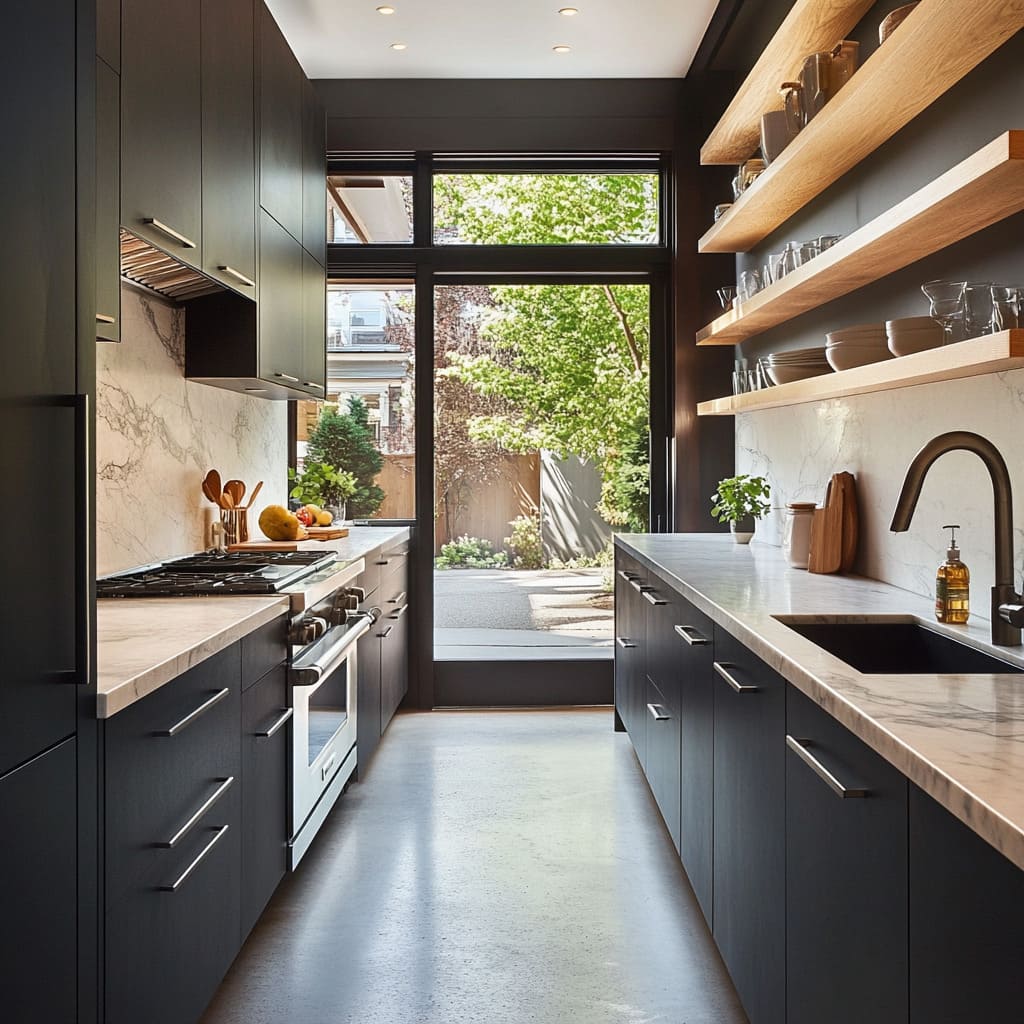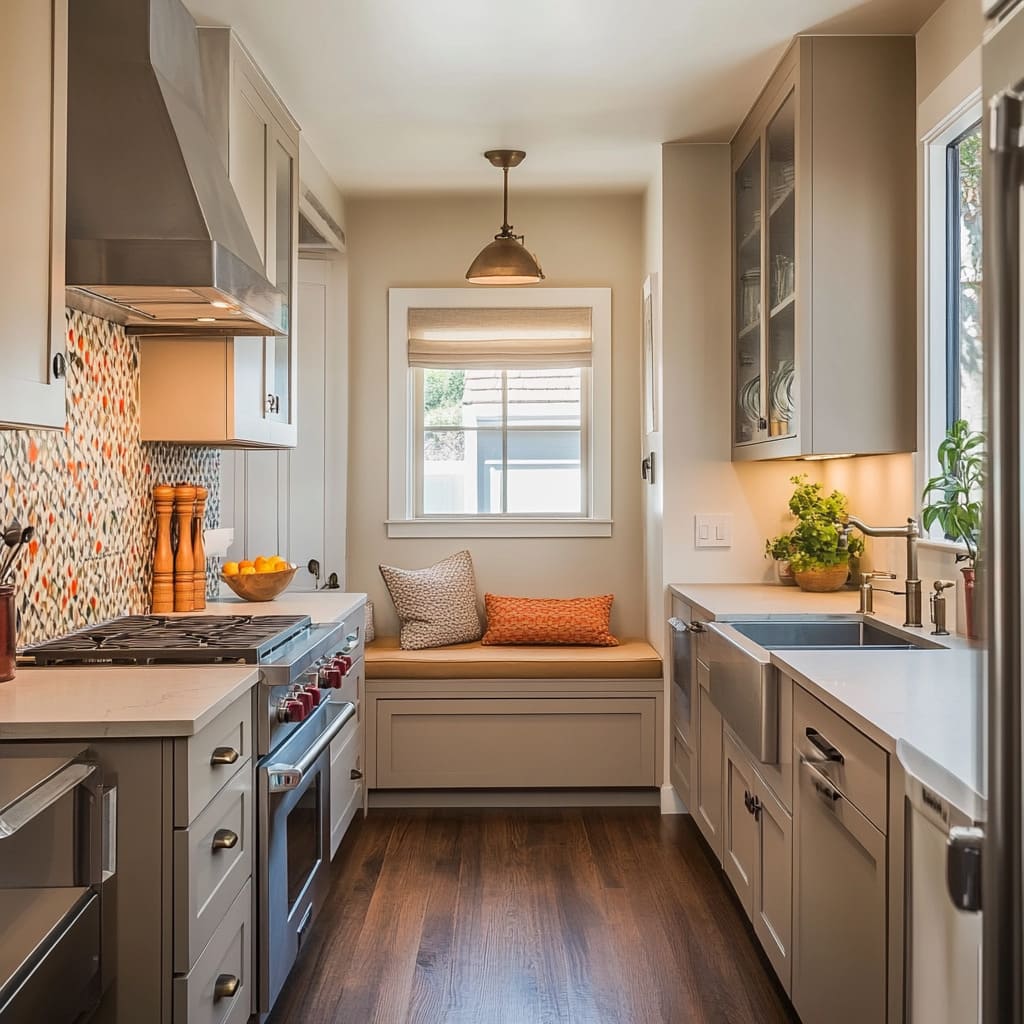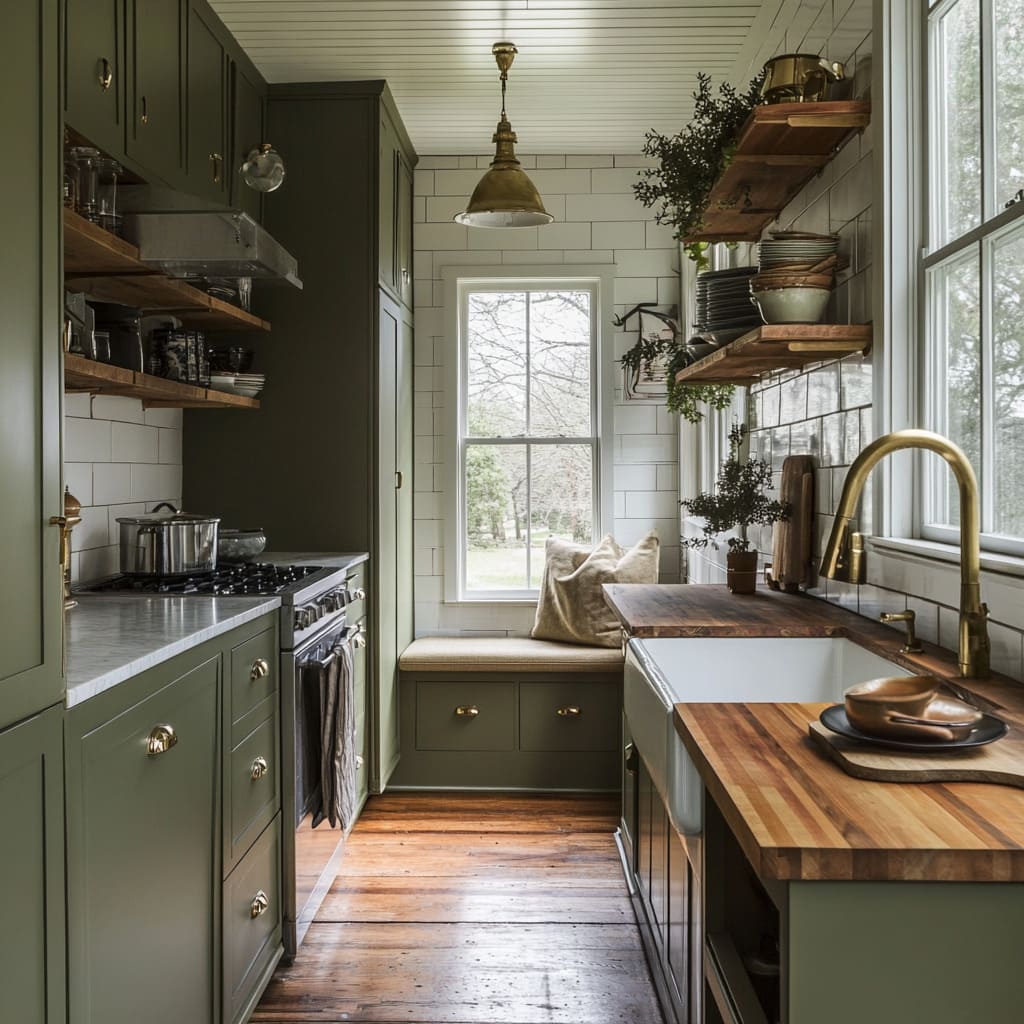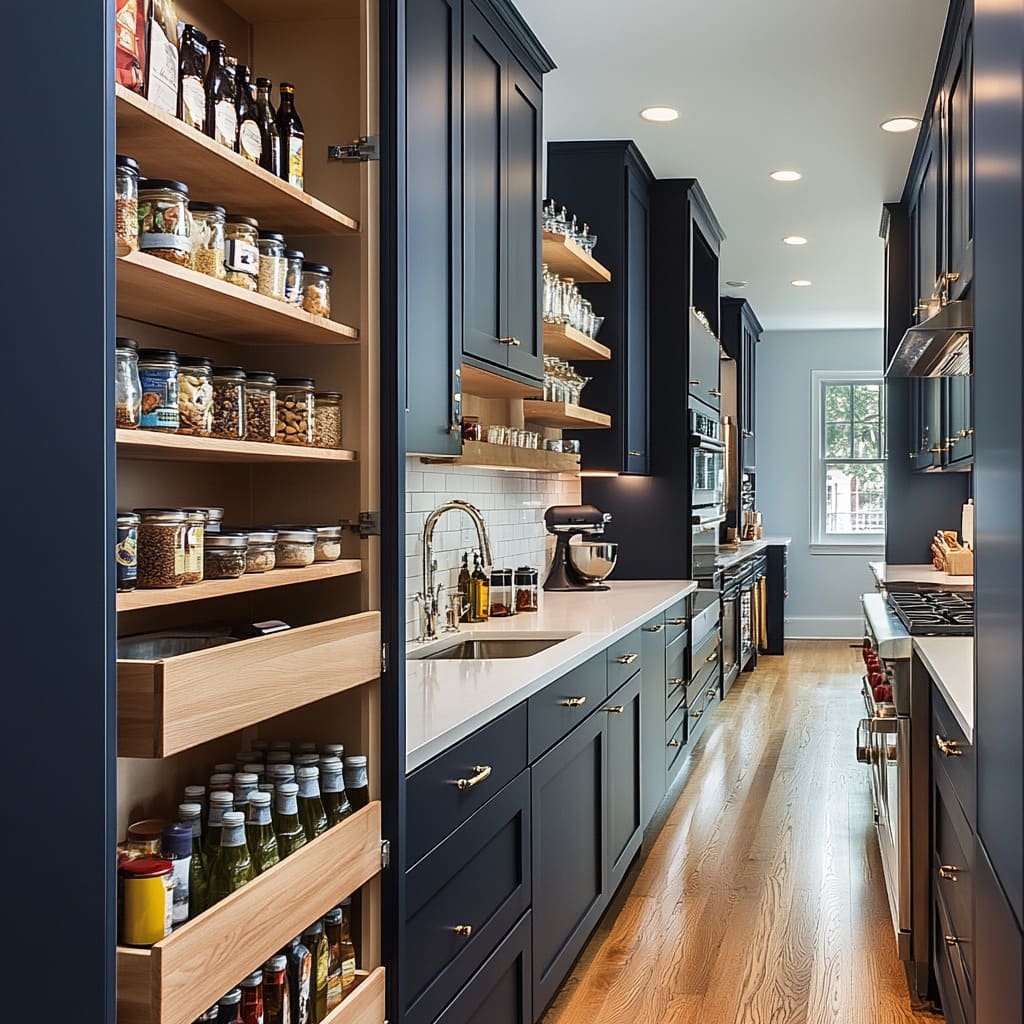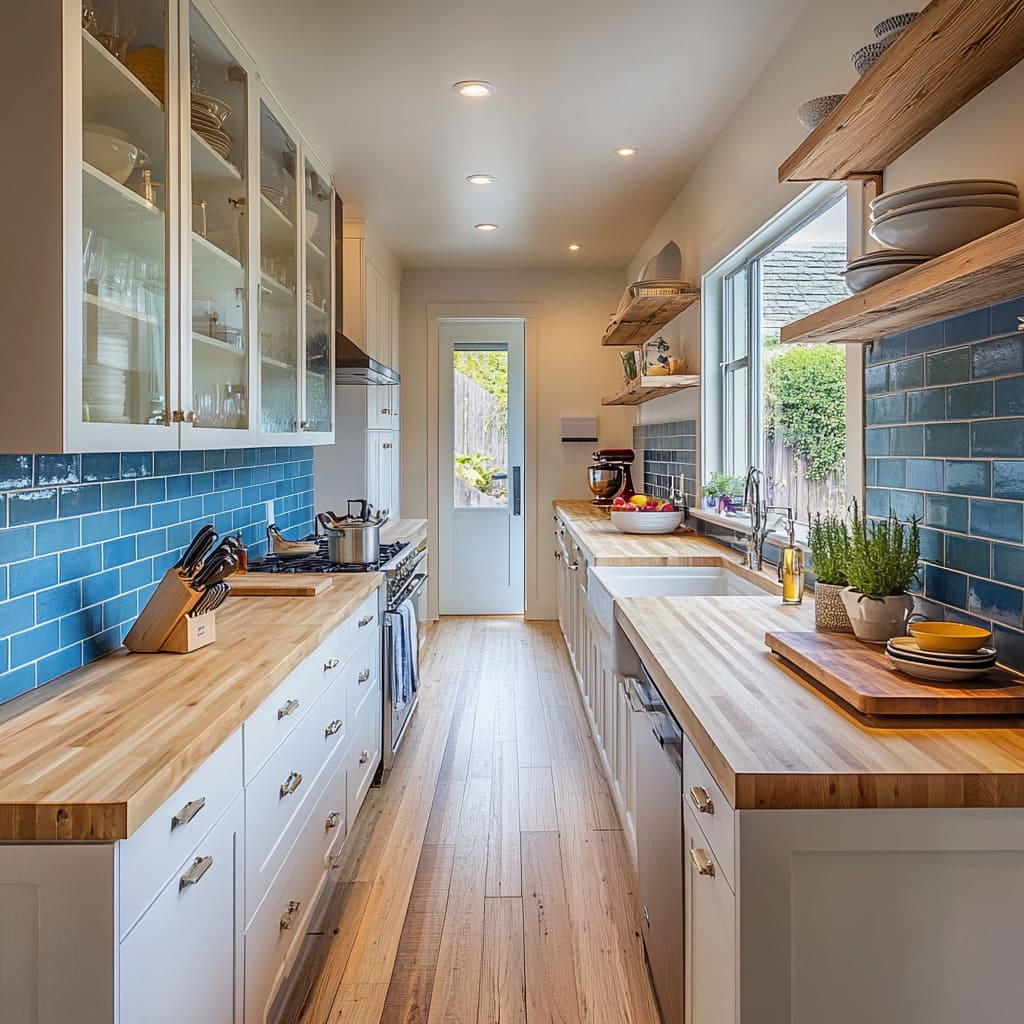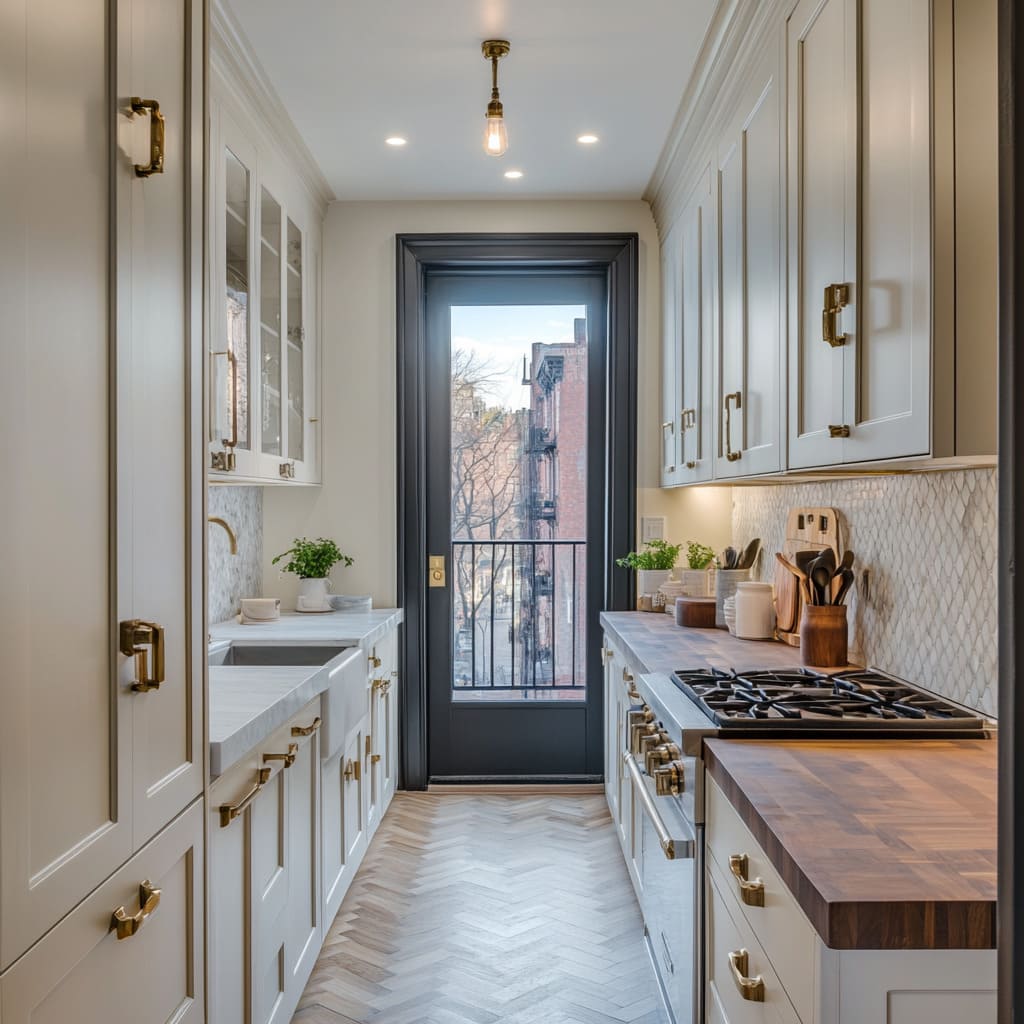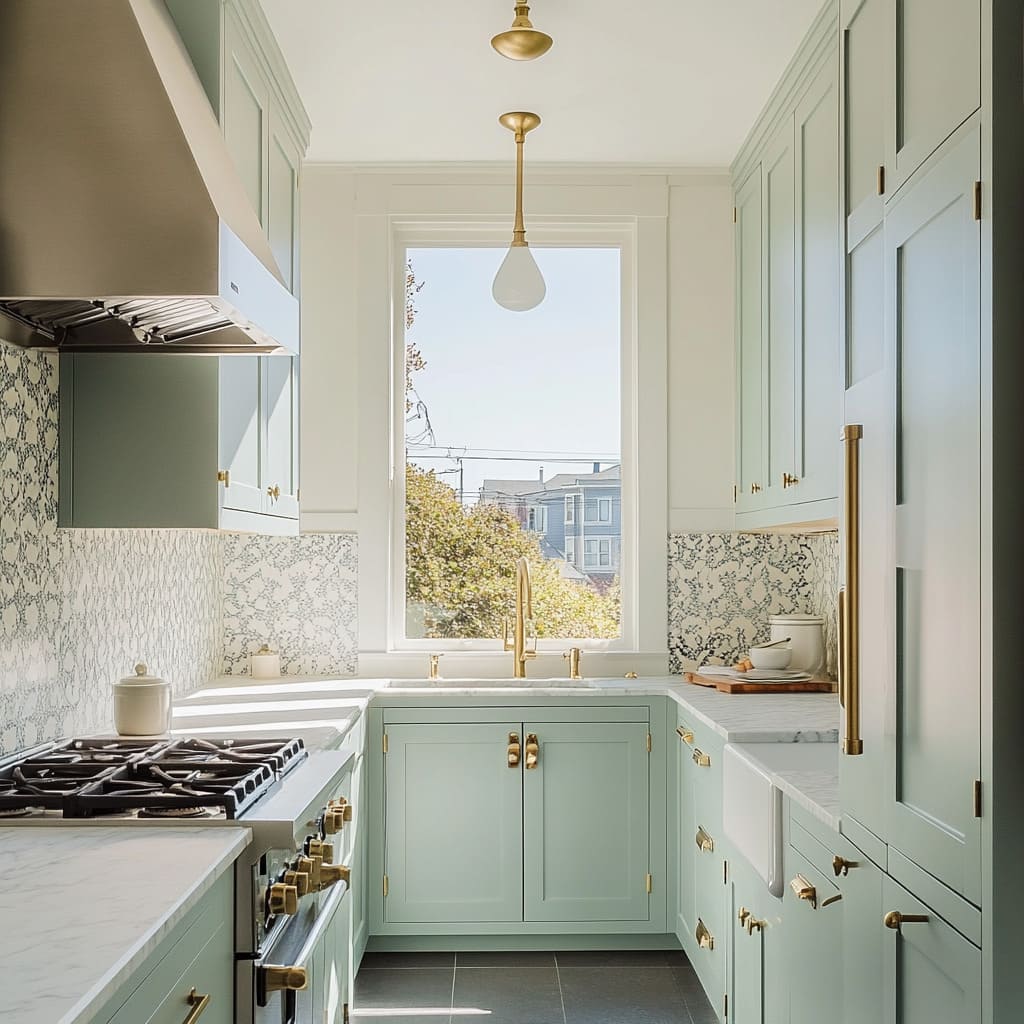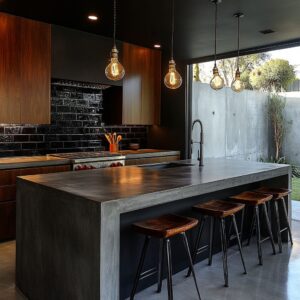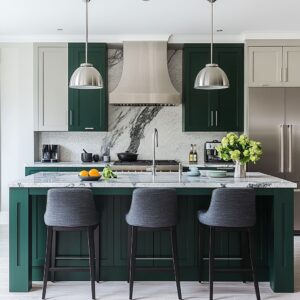Galley kitchens have long been a practical and popular choice, especially in homes where space is at a premium. Named after the compact cooking areas found on ships, these kitchens are typically designed with two parallel countertops and cabinets, creating a streamlined and efficient workspace.
In urban environments and historical homes, such as townhouses, row houses, and shotgun houses, this layout proves invaluable. The narrow kitchen design not only maximizes available space but also offers an efficient setup that makes cooking and meal prep more manageable, even in tight quarters.
From classic brownstones in Brooklyn to vintage Victorian cottages and lofts in bustling city neighborhoods, galley kitchens adapt beautifully to various settings, blending function and style.
This article explores a range of galley kitchen ideas, highlighting how to turn these narrow spaces into stylish, functional hubs. Whether you’re working with a historic home or a modern apartment, we’ll provide inspiration for layouts, color schemes, and design elements that enhance both practicality and visual appeal.
By understanding the core principles of galley kitchen designs, you can create a space that not only looks great but also makes the most of every square inch.
Understanding Galley Kitchens
A galley kitchen is a long, narrow layout, typically characterized by two parallel runs of cabinetry and countertops. This setup forms a corridor-like space where appliances, counters, and storage units are positioned along the sides, creating a compact and efficient workflow.
The galley layout is ideal for narrow spaces, as it ensures everything is within easy reach, making cooking and cleaning up swift and seamless. The simplicity of this configuration allows homeowners to optimize the space effectively, even in homes with limited square footage.
Common Settings
Galley kitchens are often found in various types of homes, particularly those with historical or urban designs. In brownstones and row houses in neighborhoods like Brooklyn, for instance, these kitchens fit snugly into the narrow footprints of these residences.
Similarly, shotgun houses in places like New Orleans often feature this style, where the galley kitchen stretches down the middle or rear of the house. Victorian cottages and modern lofts in urban centers also frequently use this layout due to its efficiency and adaptability in compact spaces.
The galley kitchen has become a versatile solution that adapts to both older and contemporary homes alike, offering homeowners a practical and stylish way to utilize narrow spaces.
Advantages and Challenges
The primary advantage of a galley kitchen is its efficiency. The narrow setup naturally creates a functional work triangle, where the sink, stove, and refrigerator are all within arm’s reach.
This arrangement minimizes the need to move around excessively, making meal prep faster and more convenient. Galley kitchens also maximize counter space and storage within a limited area, allowing for ample cabinetry, shelving, and appliance integration.
However, this style isn’t without its challenges. Given the confined width, it may feel tight, especially when multiple people are working in the kitchen at the same time.
Lighting can also be an issue, as natural light might be limited, making it essential to use bright finishes, reflective surfaces, and well-placed artificial lighting to open up the space visually. By addressing these challenges with smart design choices and focusing on efficient use of space, homeowners can transform even the smallest galley kitchen into a stylish and functional area.
Stylish Design Inspirations for Galley Kitchens
A galley kitchen, despite its compact size, can be a canvas for a range of stylish and functional designs. Whether you’re dealing with a historic property or a modern loft, these spaces provide ample opportunities to infuse character and charm.
Let’s explore several galley kitchen styles, each offering its own unique blend of aesthetics and practicality.
Classic Elegance: Ideas for Incorporating Timeless Elements
Classic design thrives in galley kitchens, particularly in historical homes like Victorian cottages. The use of deep, rich colors such as navy blue or emerald green for cabinetry creates a sophisticated backdrop.
Pair this with white marble countertops, especially Carrara marble, to add a touch of luxury and a sense of timelessness. Brass hardware and vintage-style faucets complete the look, adding a warm, gleaming contrast that highlights the kitchen’s refined character.
The classic combination of brass and marble brings depth to narrow kitchen ideas, making them not only functional but also eye-catching. These high-end materials, although luxurious, are also durable and practical for a busy kitchen space.
Incorporating open shelving to display glassware and fine china can add to the vintage charm while providing easy access to essentials. This approach not only maximizes storage but also enhances the visual appeal, turning the galley kitchen into a standout feature of the home.
Scandinavian Simplicity: Embrace Minimalist Design Principles
Scandinavian-inspired galley kitchens are all about keeping things simple, light, and functional. In mid-century homes, light oak cabinetry paired with white or neutral countertops creates a bright, uncluttered environment that feels open despite the narrow layout.
This minimalist approach is ideal for very small galley kitchen ideas, where every element needs to be purposeful yet stylish. Using open shelving instead of upper cabinets not only saves space but also creates an airy, spacious feel.
Light wood finishes keep the kitchen grounded and natural, while small potted plants or ceramic dishes displayed on the shelves add personality without overwhelming the space. Prioritizing natural light is key; installing a large window at the end of the kitchen or adding reflective surfaces can make the area feel more expansive.
This design is perfect for those seeking simplicity while maintaining a sense of style and warmth in their narrow kitchen.
Industrial Chic: For Modern Lofts and Urban Settings
Industrial chic is a bold choice for galley kitchens, especially in lofts and urban apartments like those found in Williamsburg. The style revolves around the use of raw materials—matte black cabinetry, metal shelving, and polished concrete countertops work together to create a rugged, edgy vibe.
These materials not only offer a distinctive look but also provide durability, which is ideal for high-traffic kitchens. Incorporating steel beams or reclaimed wood shelves adds an industrial edge, making these small galley kitchen ideas on a budget both stylish and affordable.
Exposed pipes and brick walls can enhance this urban feel, while a long pendant light or Edison bulbs above the counter add warmth and charm without detracting from the overall raw aesthetic. In narrow spaces, embracing this straightforward, open approach can transform a simple layout into a statement feature, making it both functional and visually engaging.
Coastal and Cottage Charm: Designs for Seaside and Country-Inspired Homes
Galley kitchens aren’t limited to city settings—they can also bring coastal charm to cottages and seaside homes. Coastal and cottage-inspired designs, such as those seen in the picturesque homes of Carmel-by-the-Sea, make use of light, breezy elements like soft seafoam green cabinetry and butcher block countertops.
These features evoke a relaxed, beachy feel that suits both small and narrow spaces perfectly.
To build on this style, vintage tiles can be used as a backsplash, adding texture and interest without overpowering the small space. Open shelving, filled with crockery and glass jars, not only enhances storage but also brings a touch of character and personality.
Light wood floors create a seamless flow that enhances the kitchen’s length, making it feel connected to the rest of the home. This approach is great for homeowners looking to create a cozy, welcoming atmosphere while making the most of limited kitchen space.
With the right combination of these elements, galley kitchens can be transformed into stylish, functional spaces, regardless of their size or location. These design inspirations prove that even narrow kitchens have immense potential for creativity, allowing you to blend function and style in a way that suits your home’s character and your personal taste.
Functional Design Tips for Long and Narrow Kitchens
Designing a long and narrow kitchen requires clever solutions to ensure the space is not only functional but also visually appealing. By making smart use of vertical storage, compact appliances, lighting techniques, and space-saving features, even the smallest kitchen can become a highly efficient and stylish area.
Below are some effective strategies to maximize every inch of these tight spaces.
Maximizing Vertical Space
When working with a narrow kitchen, making use of vertical storage is essential. In galley kitchens, tall cabinets that extend all the way to the ceiling can provide ample storage for dishes, cookware, and pantry items.
This approach not only increases storage capacity but also helps draw the eye upward, creating the illusion of a taller space. Incorporating pull-out pantry solutions within these tall cabinets ensures that even the deepest corners are easily accessible, preventing clutter.
Example: In row houses like those found in Georgetown, Washington, D. C.
, tall cabinetry plays a crucial role in maintaining both functionality and style. With narrow kitchen layouts, homeowners can take advantage of the height available by integrating slim, pull-out shelves that neatly store kitchen essentials without taking up floor space.
Additionally, open shelving above counters can be used to display attractive dishware and decorative items, further enhancing the kitchen’s appearance while keeping everything within reach.
Integrating Compact Appliances
To make the most of small galley kitchen designs, choosing the right appliances is critical. Compact and multi-functional appliances can be lifesavers in tight spaces.
Slim fridges, induction cooktops, and under-counter ovens help free up countertop and floor space, while still providing all the essential cooking features. By blending these appliances seamlessly with the cabinetry, you create a streamlined look that keeps the kitchen neat and uncluttered.
Example: In Uptown, Dallas, galley kitchens often showcase this approach by integrating compact appliances that fit neatly within custom cabinetry. These kitchens make use of narrow, built-in fridges and induction cooktops that offer all the necessary cooking power without compromising on space.
Hidden appliances like built-in microwaves or dishwashers also help maintain a clean, cohesive appearance, blending seamlessly with the kitchen’s design. This approach ensures that every inch is put to good use without making the space feel cramped.
Clever Use of Lighting
In long and narrow kitchen spaces, proper lighting is vital for creating depth and ambiance. Installing a combination of under-cabinet LED lighting, pendant lights, and wall sconces can brighten work areas and bring warmth to the overall space.
Under-cabinet LEDs, in particular, are excellent for illuminating countertops, making them ideal for food preparation and cooking tasks. Pendant lights or wall sconces add a decorative touch, providing focused light without taking up counter or floor space.
Example: Parisian-inspired galley kitchens in Society Hill, Philadelphia, are known for using vintage sconces and pendant lights to create a warm, welcoming glow. These kitchens often feature brass or bronze wall sconces that add character and help illuminate narrow spaces effectively.
Under-cabinet lighting in these setups is typically installed to highlight marble countertops and reflective backsplashes, making the kitchen appear brighter and more open. By layering these lighting sources, the space feels more expansive and visually interesting, even in tight quarters.
Space-Saving Storage Solutions
For efficient kitchen designs for galley kitchens, innovative storage solutions are key. Pull-out cutting boards and retractable countertops are great options for increasing workspace without permanently occupying space.
Foldable dining nooks or wall-mounted tables can be used when needed and tucked away when not in use, providing flexibility without crowding the kitchen. Example: In the shotgun houses of Austin, foldable tables and pull-out extensions are often utilized to maximize every bit of counter space available.
These small galley kitchens are cleverly designed with fold-down tables that double as prep areas or casual dining spots, offering practicality without sacrificing movement. Pull-out cutting boards are another efficient addition, providing temporary workspace that easily slides back into place when not needed.
These solutions ensure that even in compact kitchens, the space remains functional and adaptable.
By combining these functional design tips, homeowners can transform even the smallest and narrowest kitchens into efficient, stylish spaces that make everyday tasks easier. From tall cabinets and compact appliances to thoughtful lighting and versatile storage, these strategies ensure that galley kitchens are not only practical but also inviting places to cook, dine, and enjoy.
Material and Finish Ideas to Enhance the Look of Narrow Kitchens
Creating a stylish and functional narrow kitchen hinges on choosing the right materials and finishes. The right choices not only elevate the space visually but also enhance its practicality, making every inch count.
Below are some key considerations for countertops, backsplashes, and cabinet finishes that can transform any galley kitchen into a sophisticated, efficient area.
Countertops
Countertops are a significant feature in any kitchen, and they become even more crucial in a narrow layout where they run the length of the space. Material choices like white quartz, butcher block, and polished concrete can dramatically change the kitchen’s look and functionality.
- White Quartz: A popular choice for a modern galley kitchen design, white quartz provides a sleek, polished look while being incredibly durable. Its light, reflective surface helps make narrow spaces feel larger and more open. Quartz is also low-maintenance, making it a practical choice for busy kitchens where both style and function are essential.
- Butcher Block: This is a classic option that adds warmth and texture, especially in rustic or vintage-style kitchens. In places like East Nashville’s shotgun houses, butcher block countertops lend a cozy, inviting feel while offering a sturdy work surface. The wood grain breaks up the visual monotony of long, narrow counters, adding depth and character. When properly sealed, it becomes a practical and charming choice that complements the kitchen’s overall aesthetic.
- Polished Concrete: Ideal for an industrial look, polished concrete provides a sleek and minimalist surface that fits well in contemporary or urban settings. Its reflective quality can enhance natural light, making the kitchen feel more expansive. It’s a great fit for loft spaces and double galley kitchen layouts where a streamlined, modern approach is desired. The versatility of concrete also allows for customization, like embedding subtle patterns or tinting it to match the kitchen’s palette.
Backsplash Options
The backsplash is more than just a practical element; it’s an opportunity to introduce texture and style into the kitchen. From classic to bold designs, the right backsplash can set the tone for the entire space, transforming it into a visually engaging environment.
- Vertical White Tiles: These are perfect for enhancing the height of narrow kitchens. When laid vertically, white subway tiles draw the eye upward, giving the illusion of a taller space. This simple yet effective choice is often seen in small narrow galley kitchen ideas, where every design element is used to create a sense of openness.
- Hexagonal Tiles: Adding geometric patterns through hexagonal tiles creates a distinctive focal point. This approach suits both classic and contemporary designs, offering a fresh take on traditional backsplashes. The play of light on these tiles can make the kitchen feel more dynamic, especially when paired with under-cabinet lighting.
- Custom Mosaic and Art Deco Tiles: In bungalows like those in Coral Gables, Art Deco fan-shaped tiles add an elegant, vintage flair that enriches the kitchen’s character. Similarly, Moroccan-inspired tiles in Nob Hill kitchens bring in texture and color, creating a focal point that captures attention without overwhelming the space. These unique tiles work particularly well in galley kitchens, adding depth and visual interest to long, linear layouts.
Cabinet Finishes
Cabinet finishes are essential in defining the overall aesthetic and mood of the kitchen. The choice between light and dark finishes can dramatically alter the kitchen’s look, influencing how spacious or cozy it feels.
- Light, Reflective Finishes: High-gloss white or pale grey cabinets are excellent for narrow kitchens. They bounce light around the room, making it feel open and bright. In modern galley kitchen design, light cabinets are often paired with minimal hardware or handleless designs, keeping the look sleek and uncluttered. This style is particularly effective in maximizing the feeling of space, especially when paired with mirrored backsplashes or glass-fronted cabinets that reflect light and add depth.
- Deep, Rich Colors: On the other end of the spectrum, using deep tones like emerald green or navy blue can create a sophisticated, intimate atmosphere. In row houses, these colors provide a striking contrast against bright countertops and brass hardware. While dark colors might seem like an unconventional choice for small kitchens, when balanced with reflective surfaces and thoughtful lighting, they add depth and a sense of luxury. Brass or gold hardware offers a warm, timeless contrast, enhancing the rich, dramatic look of the space.
By carefully selecting countertops, backsplashes, and cabinet finishes, homeowners can craft galley kitchens that are both stylish and functional, ensuring that even the smallest spaces become dynamic and inviting places to cook and gather.
Stylish Color Schemes for Galley Kitchens
Color plays a significant role in transforming the feel of a galley kitchen, especially when the space is long and narrow. Choosing the right palette can make a kitchen feel more spacious, inviting, and cohesive.
Below are three versatile color schemes, each suited to a different style, but all aimed at enhancing the visual appeal of a galley kitchen.
Classic Monochrome
A black and white scheme is a timeless choice that never fails to make a statement. The contrast between these two shades adds depth and elegance, turning even the most compact galley kitchen into a sleek, refined space.
This combination works particularly well in high-end environments, giving the kitchen a sophisticated, modern look.
- Black and White Schemes: Incorporating black cabinets paired with white marble countertops creates a striking visual effect that is both bold and classic. Adding mirrored finishes or glossy subway tiles enhances the reflective quality of the space, maximizing light and making the kitchen appear more expansive. Using black hardware, such as matte black faucets or cabinet pulls, ties everything together, creating a cohesive and polished appearance.
- Example: Manhattan penthouse kitchens often use this approach to achieve a high-end, minimalist aesthetic. The black and white scheme, accented with sleek, mirrored backsplashes, offers a sense of luxury while ensuring that every corner of the kitchen feels bright and well-balanced. This look is perfect for those who prefer a streamlined, contemporary galley kitchen idea that remains timeless and stylish.
Earthy and Natural Tones
For a warm and inviting feel, earthy tones such as green, terracotta, and wood finishes bring a sense of nature indoors. These shades are ideal for creating a grounded atmosphere that feels cozy yet fresh.
Earthy palettes are also versatile, working well in both modern and rustic settings.
- Shades of Green and Terracotta: Using green cabinets, whether in olive or sage, adds a sense of calm while maintaining a connection to natural elements. Pairing these tones with warm brass accents and terracotta tiles can create a kitchen that feels both homely and stylish. Terracotta cabinetry or flooring, in particular, brings a rich, warm hue that enhances the overall coziness of the space.
- Wood Finishes: Incorporating natural wood, whether through countertops or open shelving, enhances the warmth of the color palette and adds texture. Using reclaimed wood for cabinetry or floating shelves not only provides an organic touch but also creates depth, which is especially useful in long narrow kitchen design.
- Example: In Houston bungalows, terracotta cabinets paired with brass hardware give the kitchen a distinctive look that feels grounded and welcoming. These combinations are ideal for adding character and warmth to a galley kitchen, ensuring that the space remains practical while also exuding charm.
Bright and Airy Neutrals
For those seeking a light and open feel, bright and airy neutrals are the perfect solution. Using shades like soft whites, light greys, and pale pastels enhances natural light, making even the smallest kitchens feel more expansive.
This approach is especially effective in Scandinavian-inspired designs, where minimalism and simplicity take center stage.
- Whites and Light Greys: A neutral palette allows for flexibility in design, giving the option to keep the space simple or to add pops of color through accessories like textiles and ceramics. White walls and cabinets paired with light grey countertops create a clean backdrop that amplifies any natural light coming into the kitchen, making the area feel more open and welcoming. These neutral tones also work well with metal accents like chrome or brushed nickel, adding a sleek touch to the overall design.
- Soft Pastels: Pale shades of blue, blush pink, or mint green can introduce a subtle hint of color while keeping the space light and airy. These hues work particularly well when paired with natural wood accents, giving the kitchen a soft and inviting vibe that doesn’t overwhelm the senses.
- Example: In the Ballard neighborhood of Seattle, Scandinavian-inspired kitchens often use whitewashed finishes and minimalist designs to create a bright, open space. The combination of light grey cabinetry with pale wood countertops and shelves provides a simple yet effective way to maximize light while maintaining a cohesive look. This approach is ideal for tiny galley kitchens where enhancing natural light and simplicity is crucial for creating an illusion of space.
By selecting the right color scheme, you can completely transform the feel of a galley kitchen. Whether you opt for a classic black and white palette, earthy tones that add warmth, or bright neutrals that open up the space, each option offers a unique way to tailor your kitchen to your style and needs.
For those looking to create a refined, functional space, exploring these color palettes provides the foundation for a beautiful and cohesive kitchen environment.
Tips for Enhancing the Length and Visual Appeal of Galley Kitchens
When working with a galley kitchen, the goal is often to make the space feel longer, brighter, and more open than its narrow layout might suggest. By using thoughtful design elements such as visual continuity, flooring choices, and natural light, it’s possible to transform even the tiniest of galley kitchens into a stylish and practical area that feels much larger than it is.
Creating Visual Continuity
One of the most effective ways to enhance the length of a galley kitchen is by creating visual continuity. This involves using elements that draw the eye along the entire length of the kitchen, helping to create a sense of flow and spaciousness.
- Long Countertops: Installing countertops that run the entire length of the kitchen without interruption emphasizes the linear aspect of the layout. Whether you choose white quartz for a modern look or a butcher block for something cozier, the key is maintaining a continuous surface that guides the eye forward.
- Mirrored Backsplashes: Mirrored or glass surfaces are excellent for elongating the space, as they reflect light and create the illusion of depth. In Miami loft kitchens, for example, mirrored backsplashes add both brightness and visual extension, making the space feel less confined. These reflective surfaces amplify the kitchen’s natural light while also creating a sleek, contemporary look that suits both large and tiny galley kitchen setups.
- Extended Floor Planks: Using long planks for the flooring, such as narrow wood strips laid parallel to the counters, further emphasizes the linear design. This not only highlights the kitchen’s length but also keeps the eye moving, creating a seamless visual flow from one end to the other.
Flooring Choices
The right flooring choice can make a huge difference in how a galley kitchen feels. To enhance the narrow and long layout, using materials and patterns that guide the eye is key.
- Narrow Plank Wood Flooring: For those who prefer a classic look, narrow plank wood flooring is a great option. The long, linear pattern of these planks naturally draws the eye along the length of the kitchen, emphasizing the layout’s depth. Light-toned woods like oak or maple are particularly effective in reflecting light, making the space feel brighter and more open.
- Patterned Tiles: Victorian-inspired checkerboard tiles, for instance, create an eye-catching contrast that enhances depth while adding a vintage charm. These tiles are commonly seen in Richmond Colonial homes, where the black and white pattern highlights the long, narrow shape of the kitchen and adds visual interest. Similarly, herringbone or chevron patterns are excellent for kitchens seeking a modern twist, as they give the space an upscale look while guiding the eye smoothly through the room.
- Continuous Flooring: Using the same type of flooring throughout the kitchen and adjoining areas can create an uninterrupted flow. This approach works well for open-plan layouts where the kitchen connects to the dining or living area, blurring the boundaries and making the entire space feel unified and expansive.
Adding Natural Light
Natural light is one of the most effective ways to transform a narrow galley kitchen. By incorporating large windows, glass doors, or skylights, you can open up the space visually, making it feel larger, brighter, and more inviting.
- Large Windows: If possible, placing a window at the end of the kitchen allows natural light to flood the space, creating an open and airy feel. In Buckhead townhouses, for example, large arched windows provide a focal point at the end of the galley kitchen, drawing the eye outward and blending the kitchen with the outside environment.
- Skylights: Installing skylights is a perfect solution for kitchens that lack wall space for windows. In Los Angeles, kitchens with skylights bring in a generous amount of light from above, brightening the room and making it feel taller and more expansive. Skylights are also a great way to add light without compromising wall space that could be used for cabinetry or shelving.
- Glass Doors: Incorporating glass doors, especially at the end of the kitchen, not only brings in light but also provides a visual connection to the outdoors. This approach is particularly effective in modern kitchens where an open, fluid connection between the indoor and outdoor spaces is desirable. In white galley kitchen ideas, for instance, glass doors paired with reflective surfaces enhance the brightness, creating a fresh and airy atmosphere.
By thoughtfully considering these elements—visual continuity, flooring, and natural light—you can enhance the appearance and feel of a galley kitchen, no matter its size. From small narrow galley kitchen ideas to more expansive versions, these strategies work to maximize space, light, and functionality, ensuring the kitchen is both a practical and stylish part of the home.
Final Touches for a Polished Galley Kitchen Look
After establishing the core design and layout, the final touches in a galley kitchen can truly define its style, making the space feel complete and cohesive. The right accessories, lighting, and hardware can elevate a kitchen from functional to polished, ensuring that the narrow space feels intentional and welcoming.
Here are some tips and ideas to achieve that refined look.
Accessorizing Smartly
Accessorizing is all about finding the balance between style and practicality. In a narrow galley kitchen, every item should serve a purpose while adding to the aesthetic appeal.
Avoid overloading the space; instead, curate a selection of pieces that enhance the kitchen’s character without cluttering the area.
- Small Plants: Incorporating small potted herbs or succulents can bring life and a splash of green to the kitchen. Not only do they add freshness, but herbs like basil or rosemary are functional, offering easy access to fresh ingredients while cooking.
- Artisanal Ceramics and Vintage Glassware: Displaying artisanal ceramics or vintage glassware on open shelves adds personality and a handcrafted touch. These pieces give a kitchen a lived-in feel, making it cozy and inviting. In Brooklyn’s Park Slope, for example, kitchens often feature curated open shelves filled with carefully chosen ceramics and retro glassware. This method not only showcases unique pieces but also makes practical use of available shelf space, allowing the kitchen to feel organized yet warm.
- Minimalist Artwork and Cookware Display: Consider hanging minimalist artwork or a small rack for copper pots to add an artistic element. These accessories can function as both decor and practical tools, fitting perfectly into a narrow kitchen without overwhelming the space.
Incorporating Lighting Fixtures
Lighting plays a crucial role in creating atmosphere and functionality in a galley kitchen. Given the narrow layout, a mix of ambient and task lighting can work wonders, enhancing the kitchen’s look while ensuring it remains practical for everyday use.
- Pendant Lights: Installing pendant lights, especially those with unique finishes or materials, can create a statement without taking up much space. In bohemian kitchens in Austin, rattan pendant lights are often used to create a warm, relaxed vibe, perfectly balancing function and style. The natural material of the rattan provides texture and soft lighting, adding an inviting glow to the kitchen.
- Under-Cabinet LED Lighting: For task lighting, under-cabinet LEDs are ideal. These fixtures illuminate the countertops, making food preparation easier while also highlighting the backsplash and counter materials. In modern galley kitchen ideas, under-cabinet lighting is often integrated with sleek designs, adding both form and function.
- Wall Sconces: Wall sconces can be another stylish addition, particularly in galley kitchens where space is limited. They can be placed strategically to enhance the overall brightness, contributing to a cozy and welcoming environment while highlighting design elements like cabinetry or decorative tiles.
Hardware and Fixtures
The choice of hardware and fixtures may seem like a small detail, but these elements are crucial in tying together the overall design of a galley kitchen. With the right materials and finishes, hardware can transform the look and feel of the space.
- Brass Hardware: In Victorian kitchens in San Francisco, brass handles and fixtures are often used to add a luxurious, timeless touch. The warmth of brass pairs beautifully with deep cabinet colors like navy or emerald, creating a striking contrast that elevates the kitchen’s visual appeal. The shine of the brass also reflects light, giving the space a bright and polished finish.
- Copper and Matte Black Finishes: For a more contemporary or industrial vibe, copper or matte black hardware works well. These finishes add an edge to modern and industrial designs, providing a sophisticated, bold look. Copper, in particular, complements wood tones and neutral colors, making it a versatile choice for various kitchen styles.
- Matte Black Fixtures: Matte black hardware is a great option for those looking to add a sleek, modern touch to a kitchen. These fixtures contrast well with both light and dark cabinetry, creating a bold, graphic effect. Whether it’s cabinet handles, faucets, or light switches, this finish offers a timeless yet trendy appeal.
Conclusion
A galley kitchen, when thoughtfully designed and accessorized, can be a standout feature in any home, regardless of its size. By incorporating smart accessorizing, appropriate lighting fixtures, and standout hardware, these narrow spaces transform into functional and stylish environments.
The versatility of the kitchen design galley layout ensures that homeowners can adapt and personalize their kitchens, turning even the smallest of spaces into efficient and polished culinary havens. From Brooklyn’s curated aesthetics to the bohemian charm of Austin’s kitchens, the right touches can truly make a galley kitchen shine, fitting perfectly into any home’s style.


